Walls that sing: Graffiti and music in Bangladesh's Long July Revolution
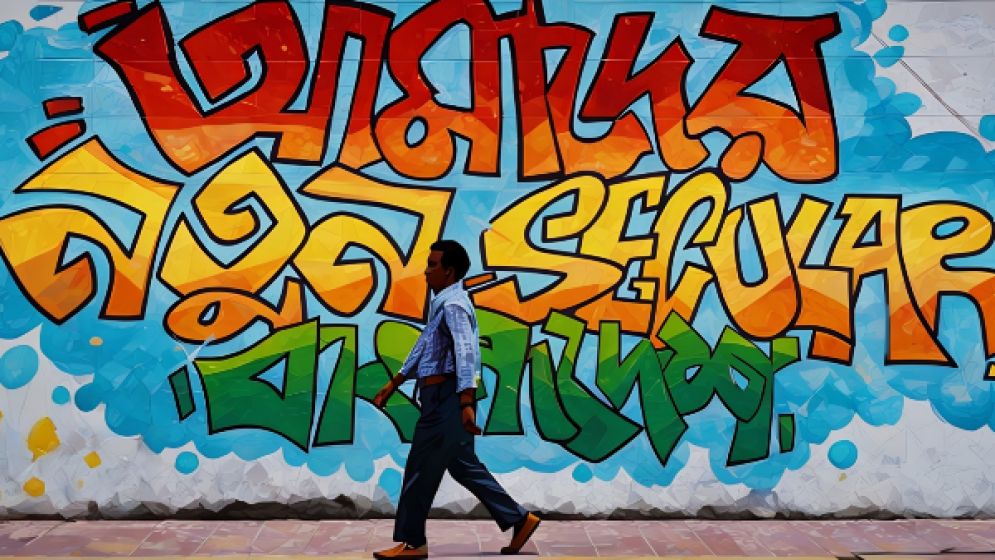
Chapter ONE
The Cultural Read-Out Of Dhaka University's Walls: July-August 2024
In Bangladesh, where political tensions often simmer beneath the surface, the walls themselves have become powerful storytellers, echoing the voices of dissent and the yearning for change.
During the oppressive years under the Awami League's rule, when freedom of expression was stifled, graffiti emerged as a potent form of resistance, a canvas for the hopes, fears, and defiance of ordinary citizens.
This wasn't the first time the walls of Bangladesh bore witness to the struggle for justice. From the fight for independence to past student-led uprisings, graffiti has long captured the spirit of resistance.
Most recently, during the tumultuous Quota Reform protests and the subsequent Anti-Discrimination Student Movement that ultimately toppled the entrenched regime, graffiti once again took center stage.
University students, facing brutal repression and the tragic loss of their peers, transformed public spaces into vibrant displays of protest. These murals not only documented the regime's violence but also gave voice to the pent-up rage fueled by years of denied justice.
Iconic images emerged, like Abu Sayed standing defiantly against police brutality and Mir Mugdho offering water bottles with the poignant question, "Pani lagbe, Pani?" ("Need water, water?"), forever etching the courage of these young activists in the nation's memory.
Even after the fall of the government, the spirit of resistance lived on in the graffiti that continued to appear. Messages of secularism and freedom covered the scars of violence, while artists addressed other pressing national issues.
Today, there is a growing movement to preserve these powerful expressions of dissent, ensuring that the stories they tell remain an integral part of Bangladesh's narrative.
These walls stand as a testament to the enduring power of the human spirit to rise against injustice and demand a better future.
Graffiti Analysis
The Quota system in Bangladesh was first introduced by Sheikh Mujibur Rehman in 1972, where a percentage of government jobs got reserved for children and grandchildren of the freedom fighters’ family.
Under the system, 44 percent of first and second-class government jobs are “merit” based. The remaining 56 percent are reserved as 30% for the children and grandchildren of freedom fighters, 10% for women, 10% “zila quota” for “backward” districts, 5% for ethnic minorities and 1% for people with physical disabilities.
In 2018, after widespread protests erupted across the country, the government issued a circular which abolished the quota system for first and second-class jobs.
However, on 5th June 2024, the High Court ruled to reinstate the 30% quota for the children of freedom fighters, declaring the 2018 abolition of quotas illegal.
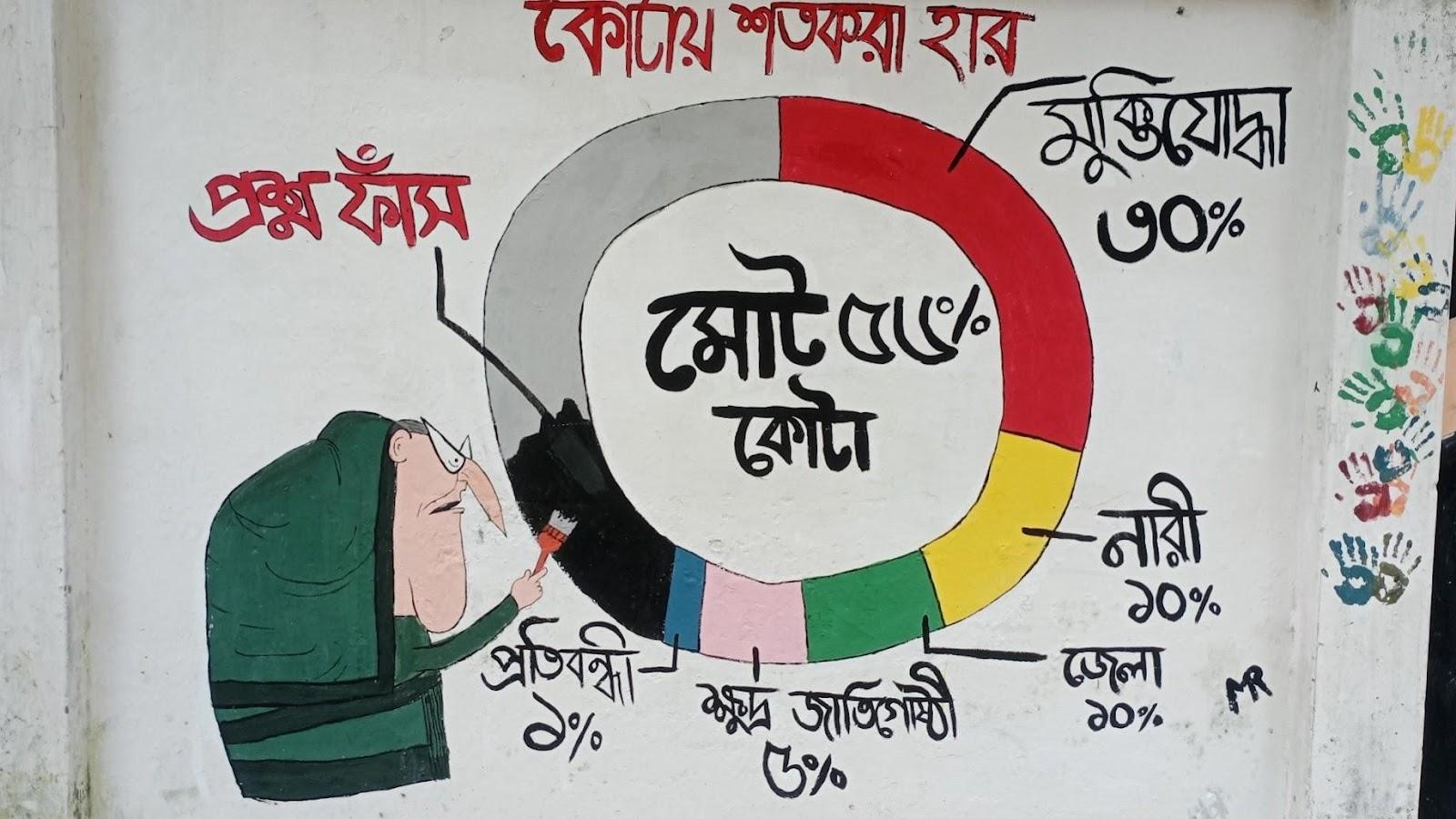
The
quota system had originally been abolished by Prime Minister Sheikh Hasina,
following mass protests. Since 3rd July, Dhaka University students had blocked
major intersections, initiating in Shahbagh. The student-led blockade of
Shahbagh, leading to the nationwide ‘Bangla blockade’ stretched over several days.
This piece of graffiti illustrates the controversy surrounding the reserved quota circular. However, former Prime Minister Sheikh Hasina is depicted via introducing a supposedly new, black marked unannounced category labeled as 'question leak’.
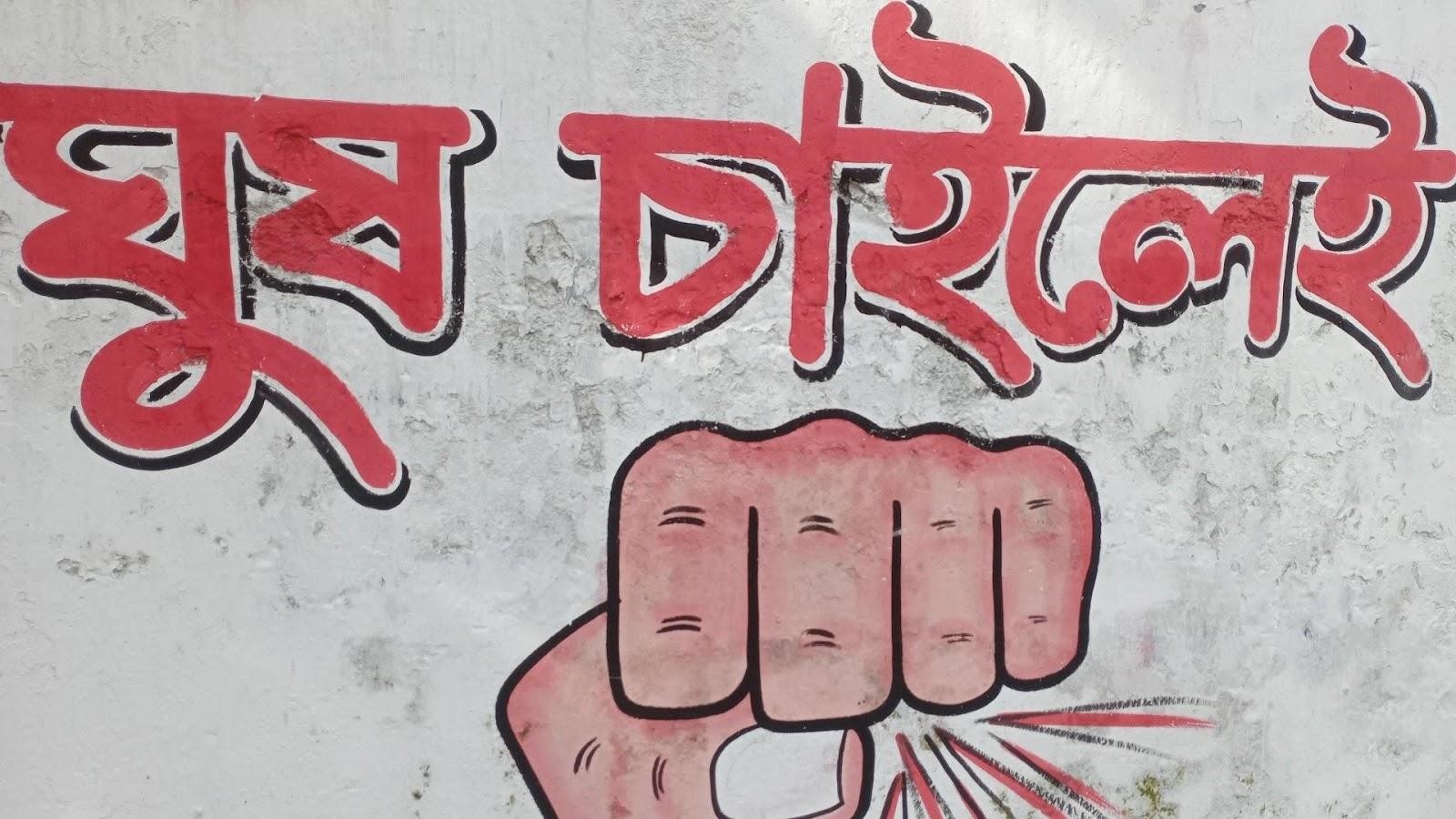
Amidst
the rising tension, despite the issue of leaked BCS exam questions being an
open secret during the tenures of multiple political parties, a significant
revelation was made on July 8, 2024.
Journalist Abdullah Al Imran of Channel 24 presented evidence of BCS question leaks, asserting that nearly all major government recruitment exams, including the BCS Preliminary, Written, and Viva stages, had been compromised for over a decade; extending to the most recent 46th BCS exam.
This exposure sparked massive outrage among BCS candidates, fueling the anti-discrimination student movement and intensifying demands for the cancellation of the 46th BCS examination.
The hashtag **#StepDownHasina** gained prominence after the controversial elections held on January 7, 2024. These elections were criticized as unjust due to allegations of voter suppression and lack of transparency.
In response, using the hashtag to demand Sheikh Hasina's resignation, students attempted to mobilize support across social media. The hashtag was a rallying point for expressing discontent with the government's actions and demanding political changes, as well as uniting various segments of society in their calls for accountability and reform.
This hashtag again gained popularity after the mass killing of student protesters for the quota reform movement.
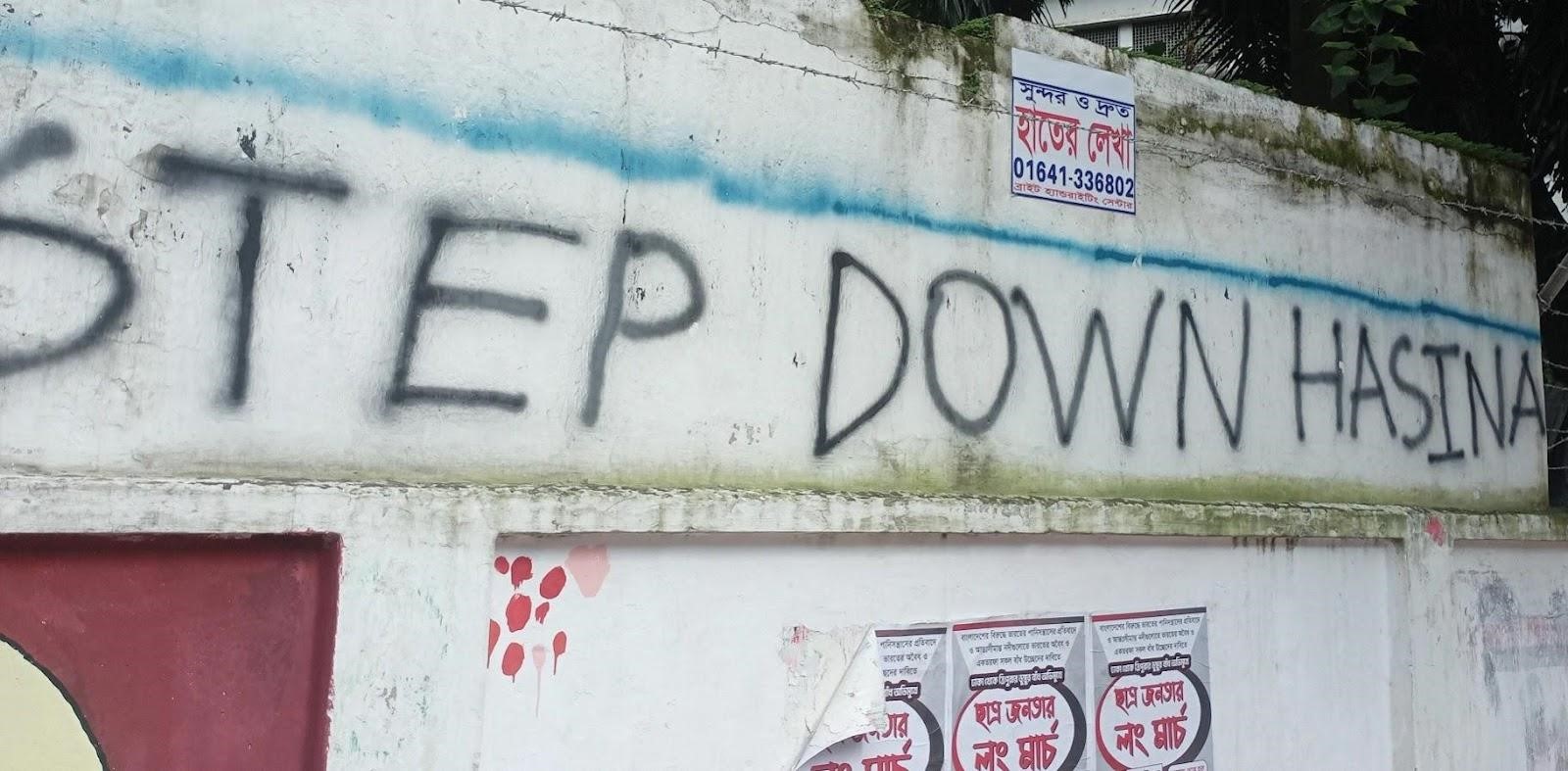
The
anti-discrimination student movement gradually escalated, contributing to the
eventual fall of Hasina’s authoritarian regime, driven by a series of
significant events– from Sheikh Hasina referring the protesters as ‘Rajakar’ to
the street killing of students starting from 15th July.
Graffiti - as a form of protest - gained momentum alongside this movement, becoming even more widespread after Hasina's resignation. Prior to her departure, wall writings had already emerged as a powerful form of resistance.
Amidst the mounting tensions and brutal crackdowns by security forces, students risked their lives to take to the streets, using graffiti to call out the autocratic system and denounce the regime with slogans such as "Student Killer Hasina’ , ‘Murderer Hasina’ and ‘স্বৈরাচার নিপাত যাক’.


Originating
from the Dhaka University campus, the flames of anti- discrimination student
protests quickly spread across the country within days, with the participation
of people from all ages and backgrounds, mirroring the rising death toll in
Dhaka and other parts of Bangladesh.
In an effort to halt the bloodshed and open negotiations, the protest coordinators presented a list of nine demands. However, despite assurances for open negotiations and discussions, the defence forces continued their violent crackdown on protesters.
In response, on August 3rd 2024, the demonstrators marched to the Central Shaheed Minar, covering the entire campus with wall writings in black and red. This was a means of demonstrating the condemnations against the government officials, police and Sheikh Hasina for the mass killings.

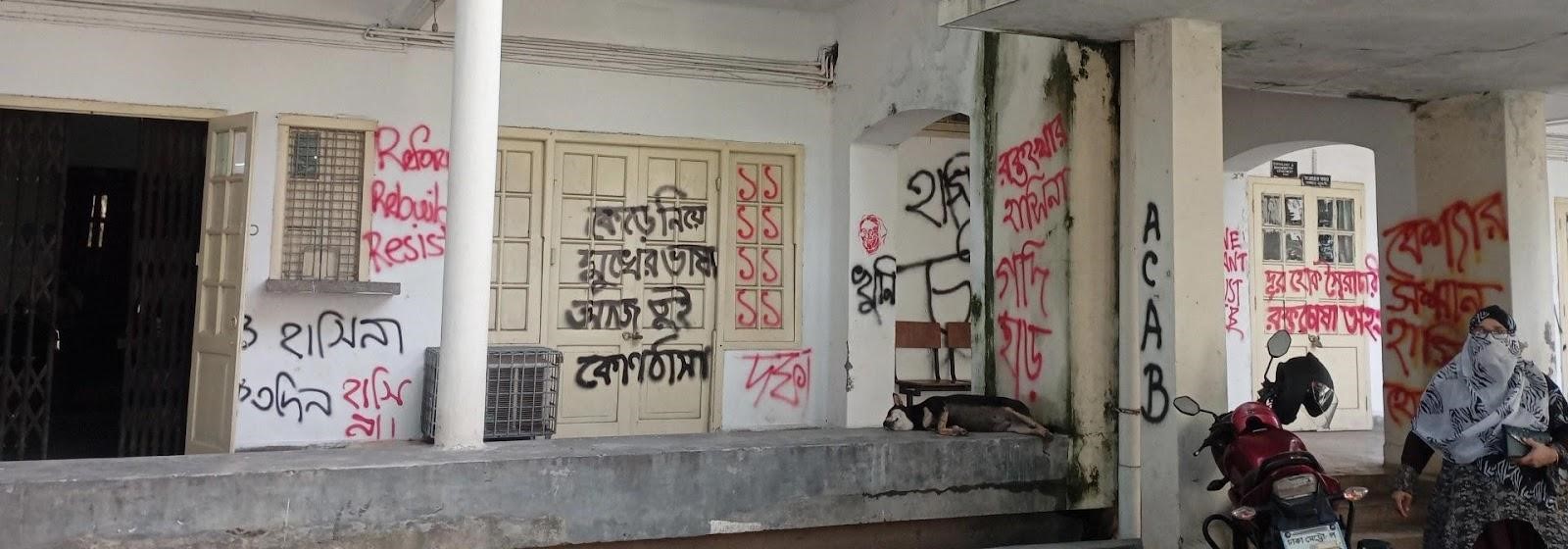
These
photos were captured at Dhaka University Medical centre.
Who is the alternative?
As the mass killing of protesters continued, the demand for Sheikh Hasina's resignation grew increasingly intense. Her government failed to contain the situation or negotiate with the students, resulting in a mounting death toll. By August 4th, the initial nine-point demands had converged into a singular clear call—Sheikh Hasina must step down.
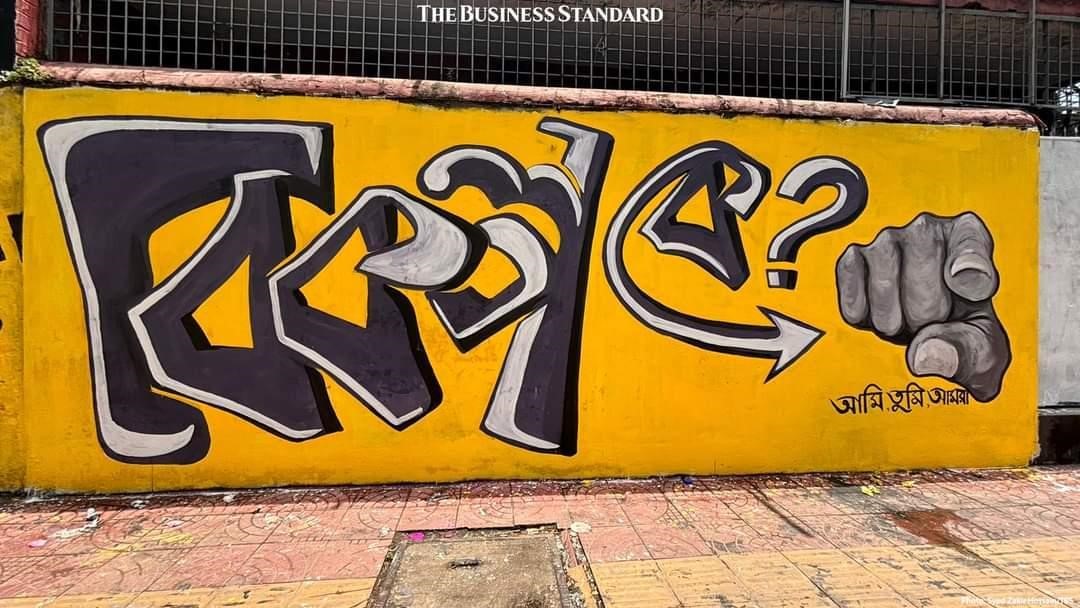
However, this gave rise to a critical question:
"Who is the alternative?" (বিকল্প কে?) After 15 years of Awami League’s authoritarian rule, and especially
following the 2024 mass killings, people began to question the future.
The protests, largely led by students—many of whom had little experience with previous regimes—created uncertainty about who could replace Hasina. Even though some placed faith in opposition parties like BNP, there was widespread reluctance to see another unelected government take control.
36th July– The birth to Bangladesh 2.0
Since the assassination of Sheikh Mujibur Rahman on August 15, 1975, the Awami League has declared August as a month of mourning. In recent years, before the regime’s downfall, the party began exerting pressure on educational institutions to forcibly organize mourning programs.
Some suggest that this was politically motivated, aiming to overshadow BNP leader Khaleda Zia’s birthday, which coincides with the same day.
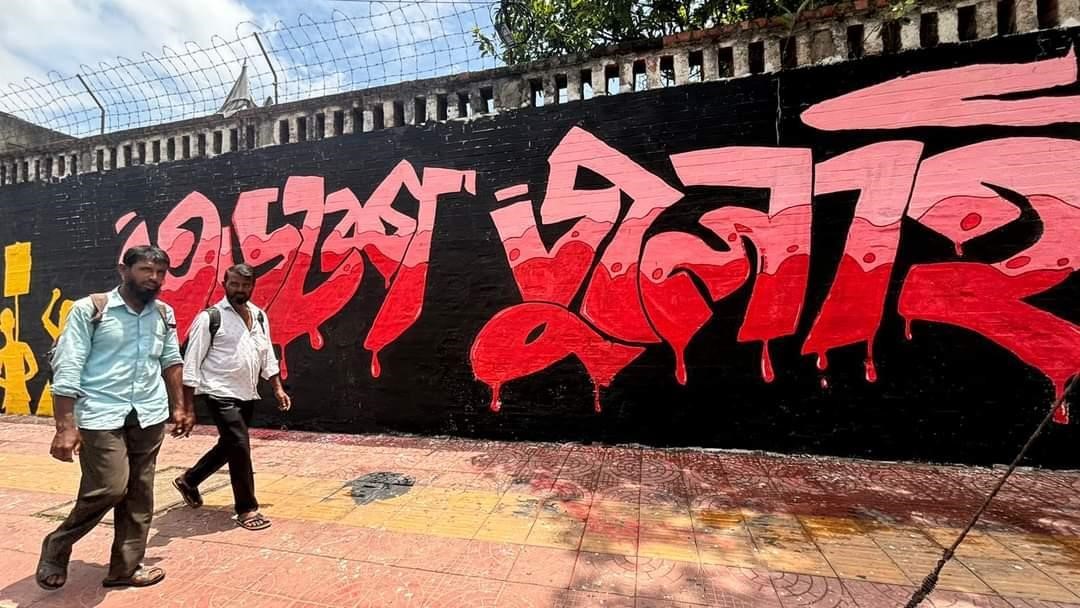
Political
or not, after the bloodshed and police brutality in July, many people felt
detached from a history they had not experienced. Instead, their focus shifted
to the present atrocities they had witnessed firsthand.
As a result, the protests and griefs from July extended well into August. Citizens refused to acknowledge August’s arrival, counting the days as an extension of July—marking August 5th, for example, as "36th July."
On that day, as Sheikh Hasina resigned and fled the country, the people felt they had finally achieved justice. The day was declared a second independence day, marking the birth of "Bangladesh 2.0," a new chapter free from tyranny.
Solidarity
beyond borders
During the protests to dismantle authoritarian rule in Bangladesh, the students made sure to extend their solidarity beyond borders.
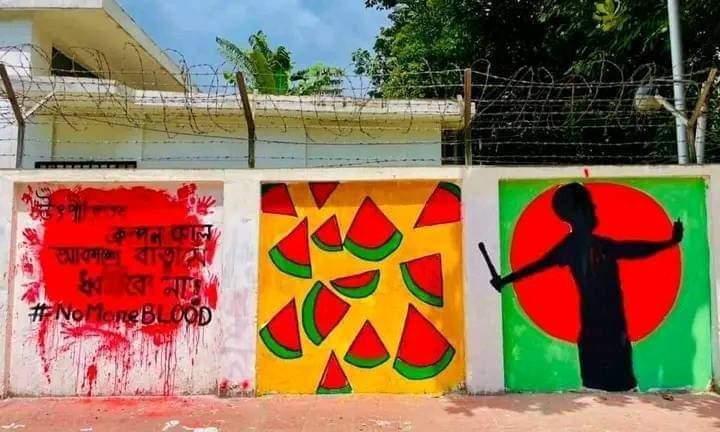
Graffiti
on the walls of Dhaka was not only a form of resistance against local tyranny
but also a tribute to the past long struggles of the Palestinian people.
Slogans and murals supporting Palestine were intertwined with Bangladesh's
fight for freedom - symbolizing a shared fight against oppression.
The students, while demanding justice at home, echoed the cries for Palestinian liberation, linking the two nations in their common quest for freedom and human rights.
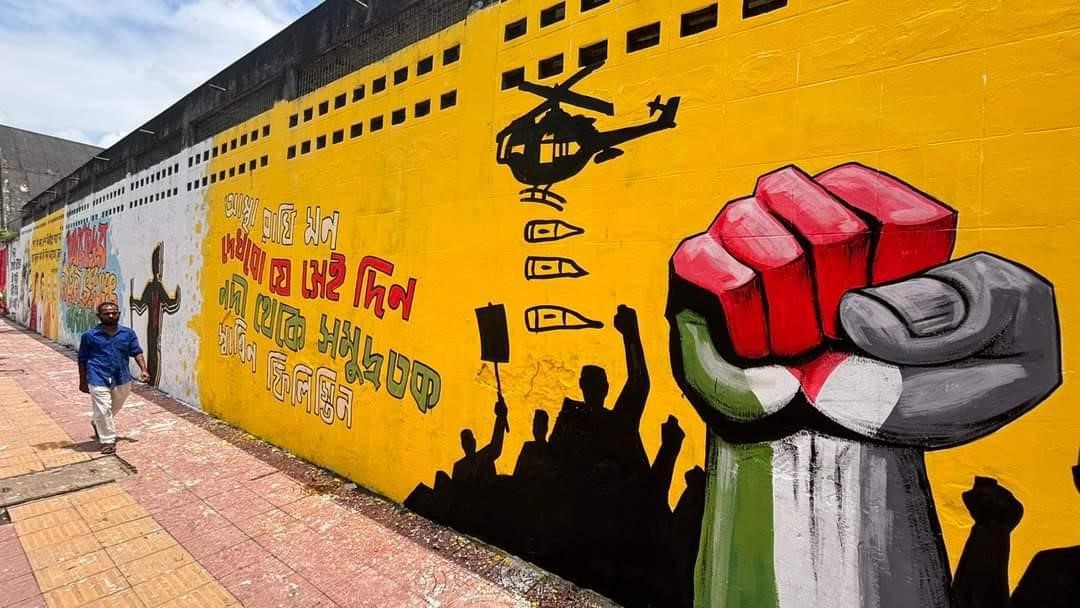
Urgency
for Political Discussion
Political discussions at tea stalls, once a vibrant part of Bangladeshi culture, had gradually diminished over the years. Many reasons contributed to this decline: limited freedom of expression, restrictive laws like the Digital Security Act, and a growing apathy towards politics.
Heated debates often led to conflict, resulting in formal or informal bans on political conversations in public spaces.
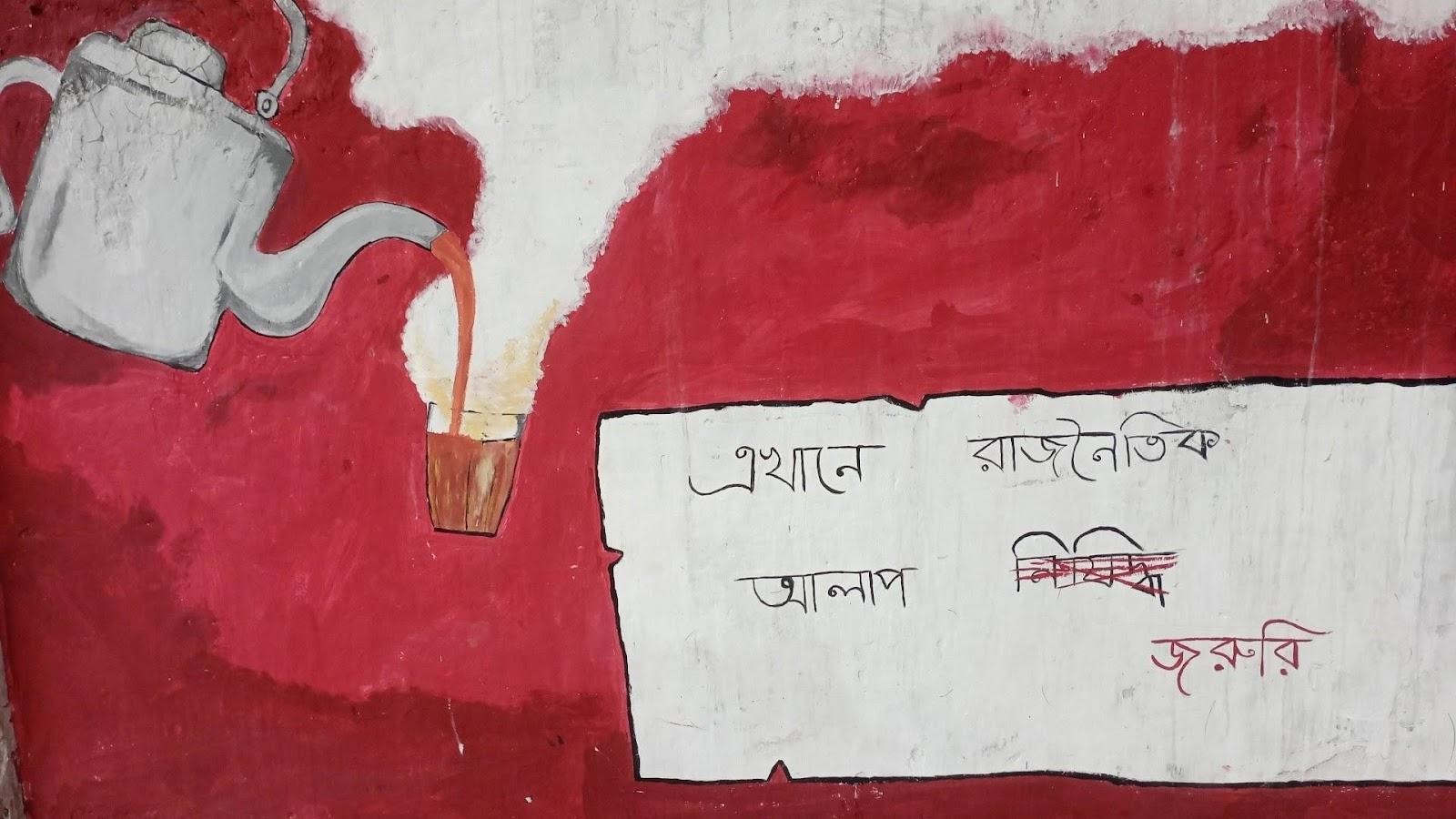
However,
as political tensions have escalated, the scenario is shifting. People are once
again eager to engage in political discussions, debating future governance,
addressing failures, and expressing their hopes. What was once discouraged has
now become essential — from ‘political discussion is banned here’ to ‘political
discussion is a need’.
Hasina's exit and Delhi's dominance
On 5th August, 2024, after Sheikh Hasina’s resignation, she flew away to Delhi, India. That upsurged the controversies regarding India's involvement in Bangladesh’s internal affairs.
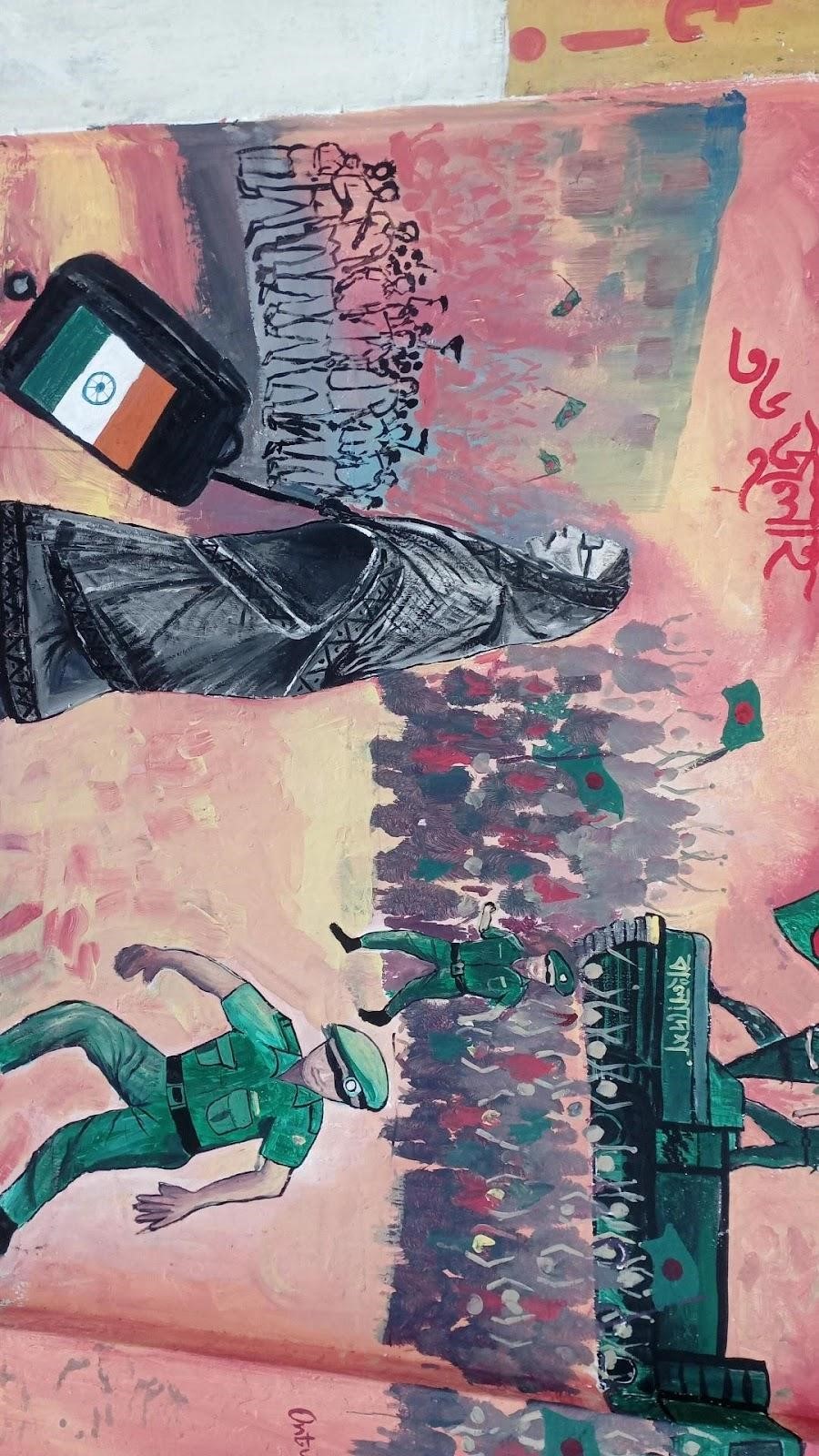
India’s
longstanding influence in Bangladesh has come under strain following the sudden
ouster of Sheikh Hasina during nationwide protests led by students. For over 15
years, India, under its “neighbourhood first” policy, maintained strong ties
with Hasina; endorsing her government despite allegations of vote-rigging and
controversial elections.
This unwavering support has contributed to growing resentment among many Bangladeshis, who view Delhi as a backer of authoritarianism.
Under Hasina, India benefited from cooperative efforts to curb these insurgencies and resolve border disputes. Furthermore, trade relations flourished, with India gaining key transit routes through Bangladesh, facilitating economic access to its remote northeastern regions.

With
Hasina’s fall, Delhi faces a critical test in maintaining its regional
dominance, particularly as Bangladesh joins other neighboring nations, like
Nepal and the Maldives, in resisting India’s dominance. While Delhi has moved
quickly to engage with the interim government, including outreach by Prime
Minister Narendra Modi, the challenge of regaining trust in Bangladesh remains
significant. Losing influence in Bangladesh, especially as China jostles for
power in the region, could weaken India's position as a regional powerhouse.
Blood red protest
On July 29th, 2024, the Bangladeshi government announced a national mourning for the demised souls during the Quota reform protests. However, in a show of defiance, the Anti-Discriminatory Students Movement flooded social media with red profile photos and images of participants wearing red cloth around their eyes and mouths as a demonstration of rejection against the government’s recently announced mourning.
On 30th July, Facebook and other platforms were overwhelmed with red-themed images following the government's declaration; despite government organizations mourning with black themed photo.
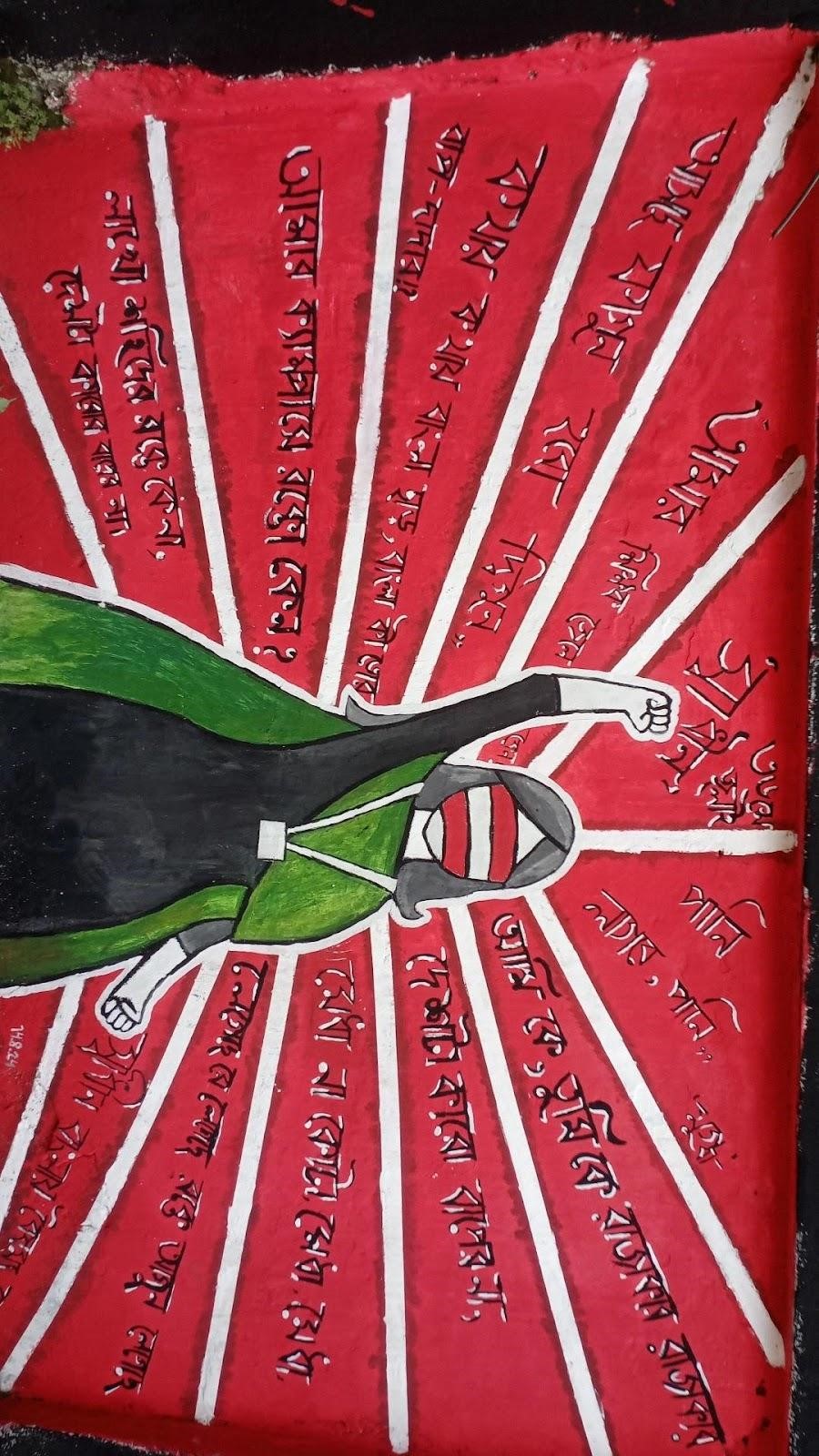
The
offline protests showed solidarity with the adoption of a new protest strategy,
emphasizing dissatisfaction with the government's handling of the situation.
This visual protest saw wide participation from teachers, cultural workers,
journalists, writers, and students - highlighting a collective demand for
justice and accountability.
During the quota movement, multiple artists and their artworks got famous. But more specifically, Debashish Chakrabarty’s works caught the most attentions.
Debashish Chakrabarty is a Bangladeshi based artist and author. Through science and arts, he explores the plasticity of the human mind. His recent works revolve around power relations and civil imaginations. He looks closely at the state mechanism, power, and production relations in order to reflect on the human conditions.
He has been using diverse kinds of optical, photographic, and drawing techniques to narrate stories that reflect various degrees of human experiences. During the quota reform protests, he openly illustrated the fascism characteristics, India’s dominant nature towards Bangladesh, and other relevent controversial issues that inspired the graffiti works after Hasina fled away.
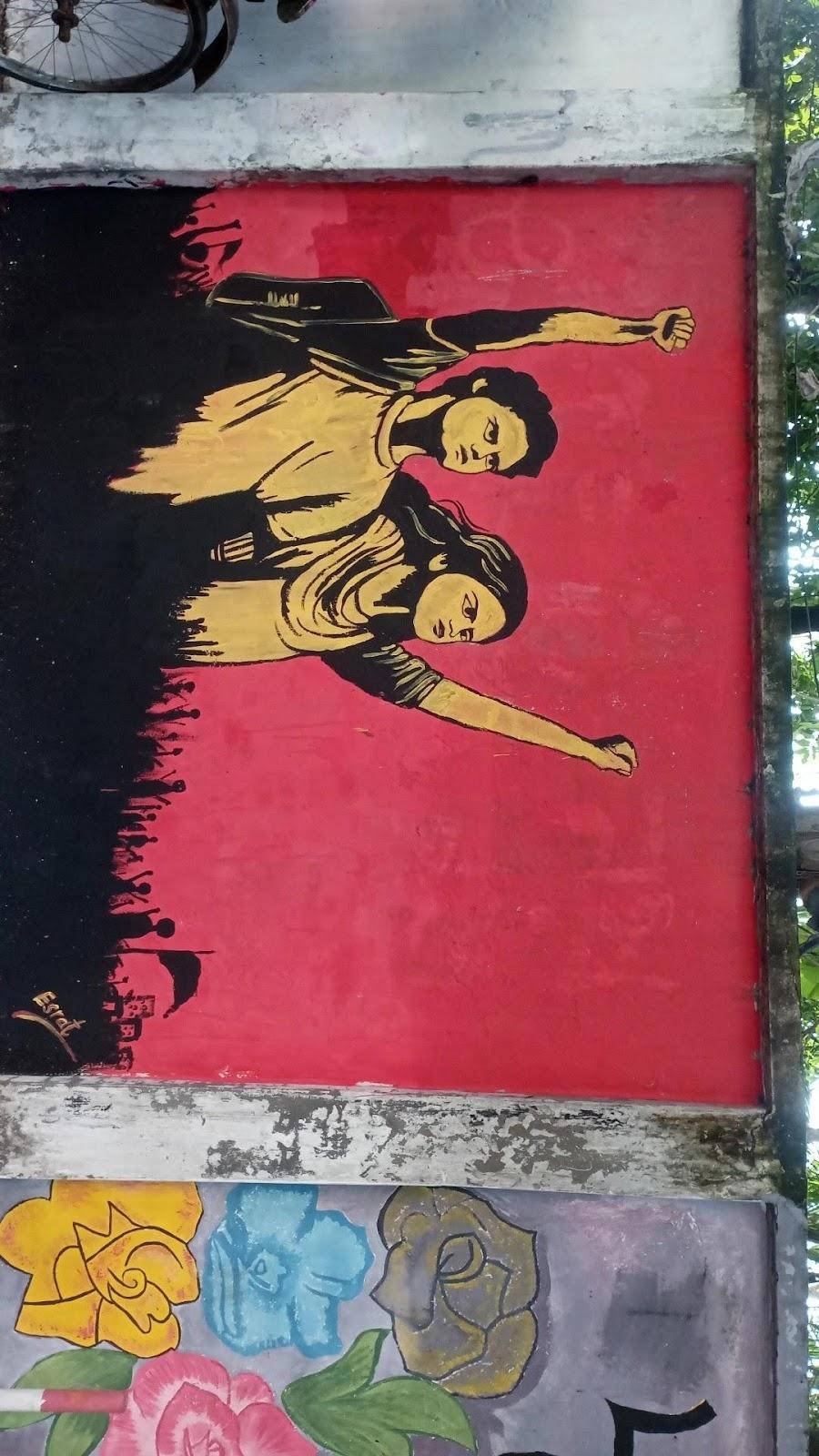
Solidarity
with Indigenous rights
The anti-discrimination student movement in Bangladesh has also highlighted the struggles for indigenous rights, which are deeply intertwined with broader themes of social justice and equity. Graffiti, as a form of protest and expression, has played a crucial role in amplifying these issues.
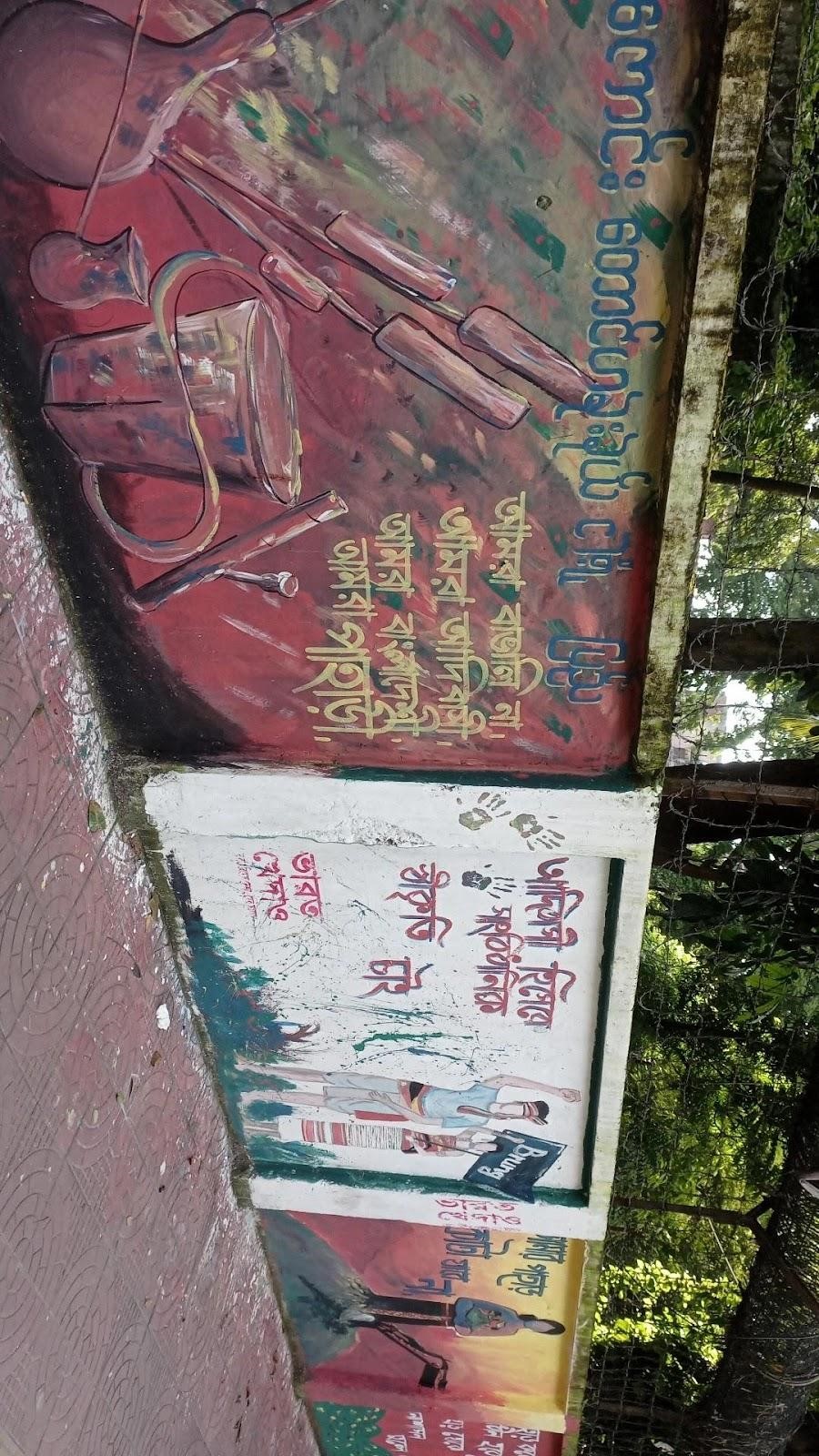
Indigenous
communities in Bangladesh, such as the Chakma, Marma and Santhal, have faced marginalization
and discrimination for decades. Their struggles are rooted in historical
injustices that include land dispossession, cultural erasure, and
socio-economic disadvantages.
The graffiti have illustrated Kalpana Chakma as well, to amplify these concerns, linking the rights of indigenous people with the broader fight against discrimination. Artists and activists have used walls and public spaces to create vibrant murals and slogans that celebrate indigenous cultures, demand recognition of their rights and call for an end to discrimination.
Martyrdom to Graffiti: Abu Sayed
Abu Sayeed, a 25-year-old student, was the first martyrdom of the anti-discrimination student movement in Bangladesh. His story began after he stood fearlessly against the police on July 16, brandishing a cricket stump and daring the regime’s brutality.
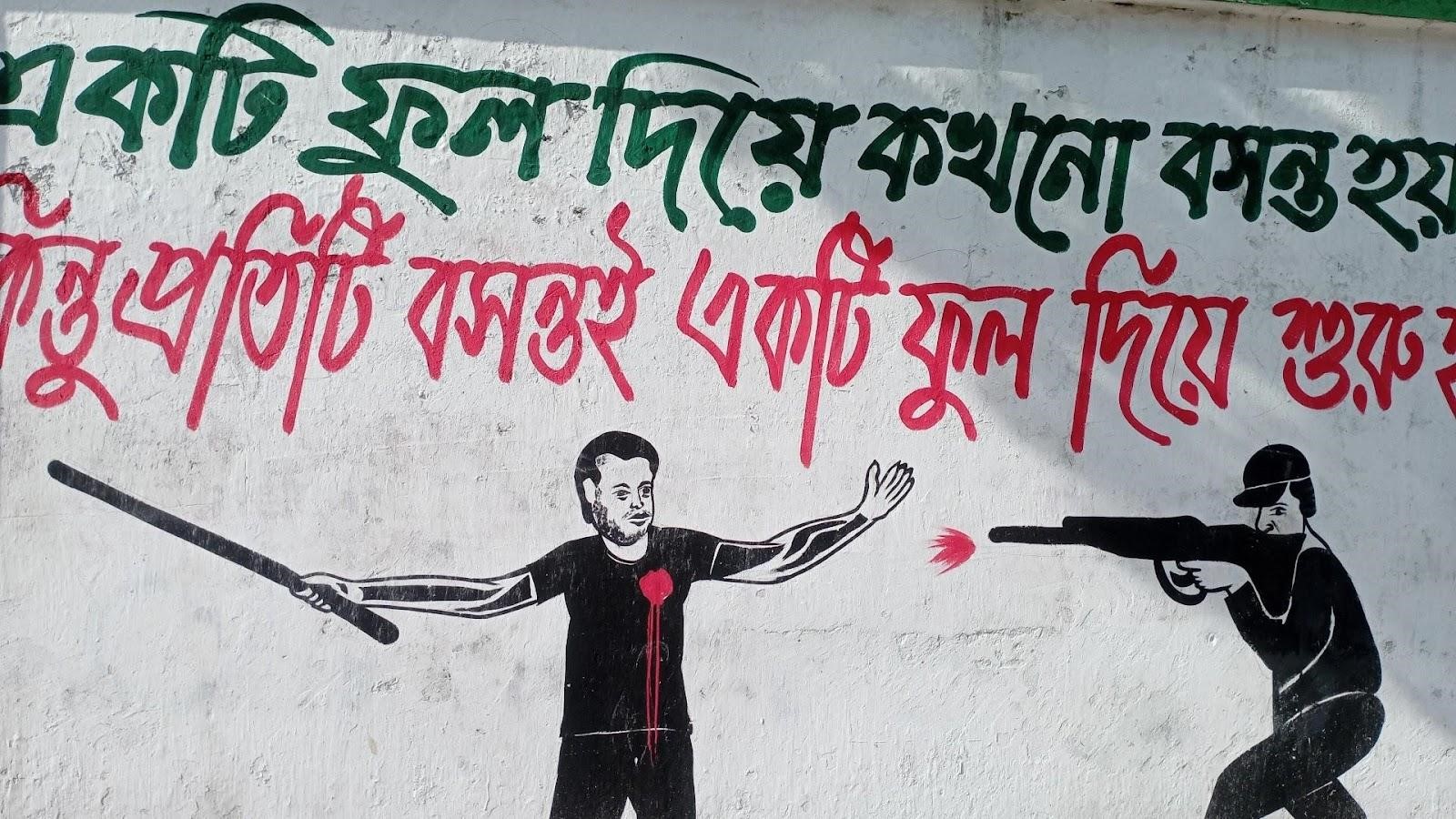
His
iconic stance, arms wide open, represented a bold challenge to the oppressive
Awami League government.
Sayeed’s sacrifice did not go unnoticed. A 48-second video of his final moments circulated rapidly on TV and social media, reaching millions of Bangladeshis and igniting a wave of outrage and solidarity.
He was hailed as the first martyr of the revolution, and his image became a rallying point for students and activists. In the days following his death, red display profile photos flooded social media; symbolizing unity and resistance.
Nationwide, the graffiti works are filled with Abu Saeed with his arms open - daring the police brutality. Murals depicting Sayeed have emerged across the city, illustrating the collective rage and determination of the people.
These artworks not only memorialize his sacrifice but also serve as a reminder of the ongoing struggle against authoritarianism in Bangladesh.
Even after his death, Abu Sayeed's legacy continues to live on in the hearts of many; etched into the walls of the city, inspiring a movement that seeks justice and freedom for all.
Mir Mugdho
The street walls in Dhaka are covered with one popular slogan, “Pani lagbe Pani?”, said by Mir Mahfuzur Rahman Mughdo, a master's student from Bangladesh University of Professionals (BUP), few moments before being shot and killed.
On July 18, amidst the chaos of the quota reform movement, he was caught in the violence that erupted in Uttara. He wasn’t there to fight but to help—distributing food, water, and biscuits to exhausted protesters.
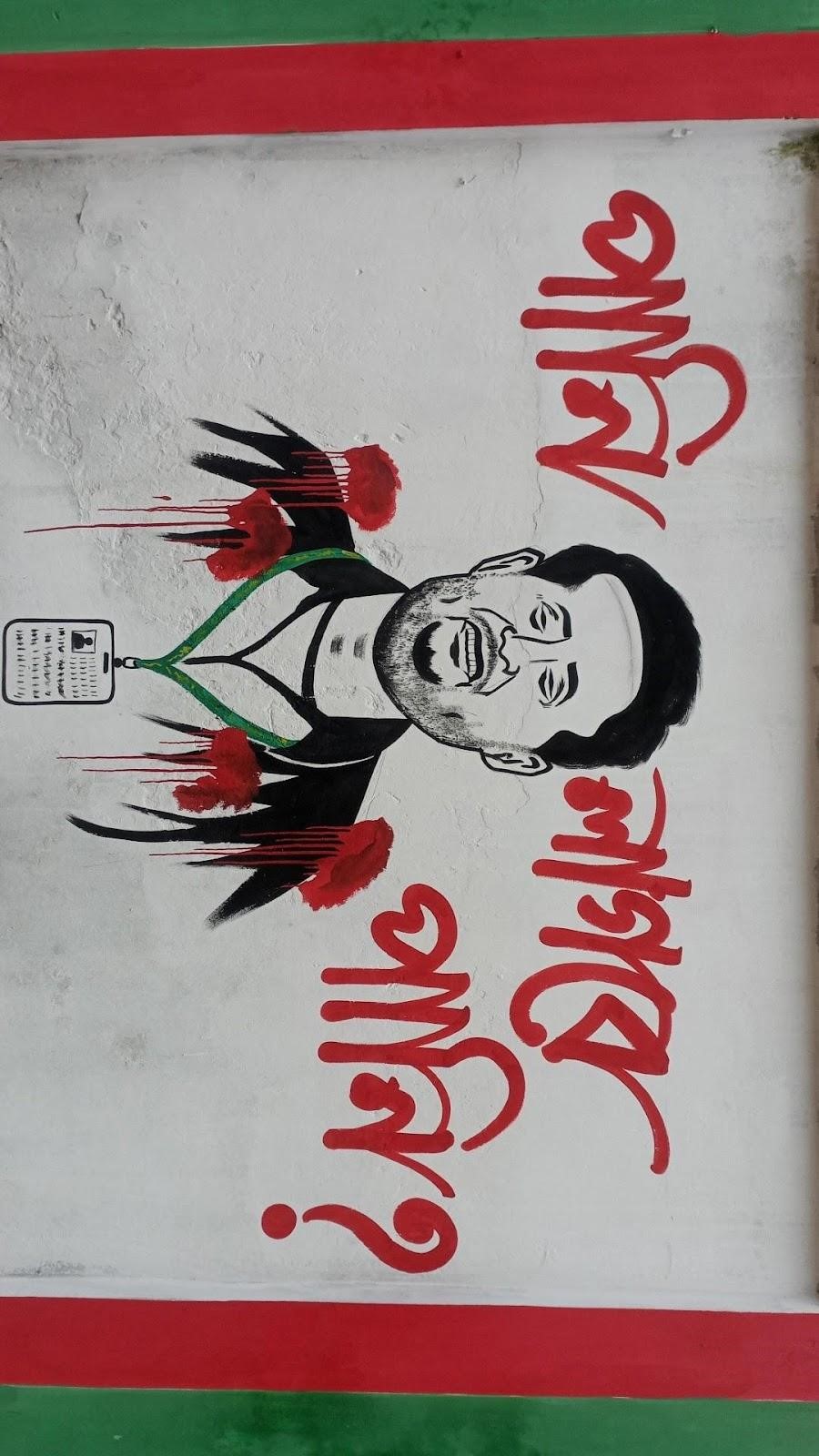
In
a video taken just 15 minutes before his death, Mughdo was seen running through
the crowd, his calm presence a stark contrast to the turmoil around him. His
final words, “Paani lagbe paani” (Do you need water?), resonated with those
around him as he handed out water bottles.
Meanwhile of this selfless act, Mughdo was shot, leaving behind a memory of quiet bravery. His death became a defining moment of the movement, with his last words echoing in the hearts of many. In tribute, protesters have even called for a share of profits from a bottled water company to be given to Mughdo’s family, ensuring his sacrifice is never forgotten.
Shykh Aash-Ha-Bul Yamin
One of the most prominent videos that captured police brutality, was when the police were exposed to scrap a protester’s body off from their vehicle without any remorse.
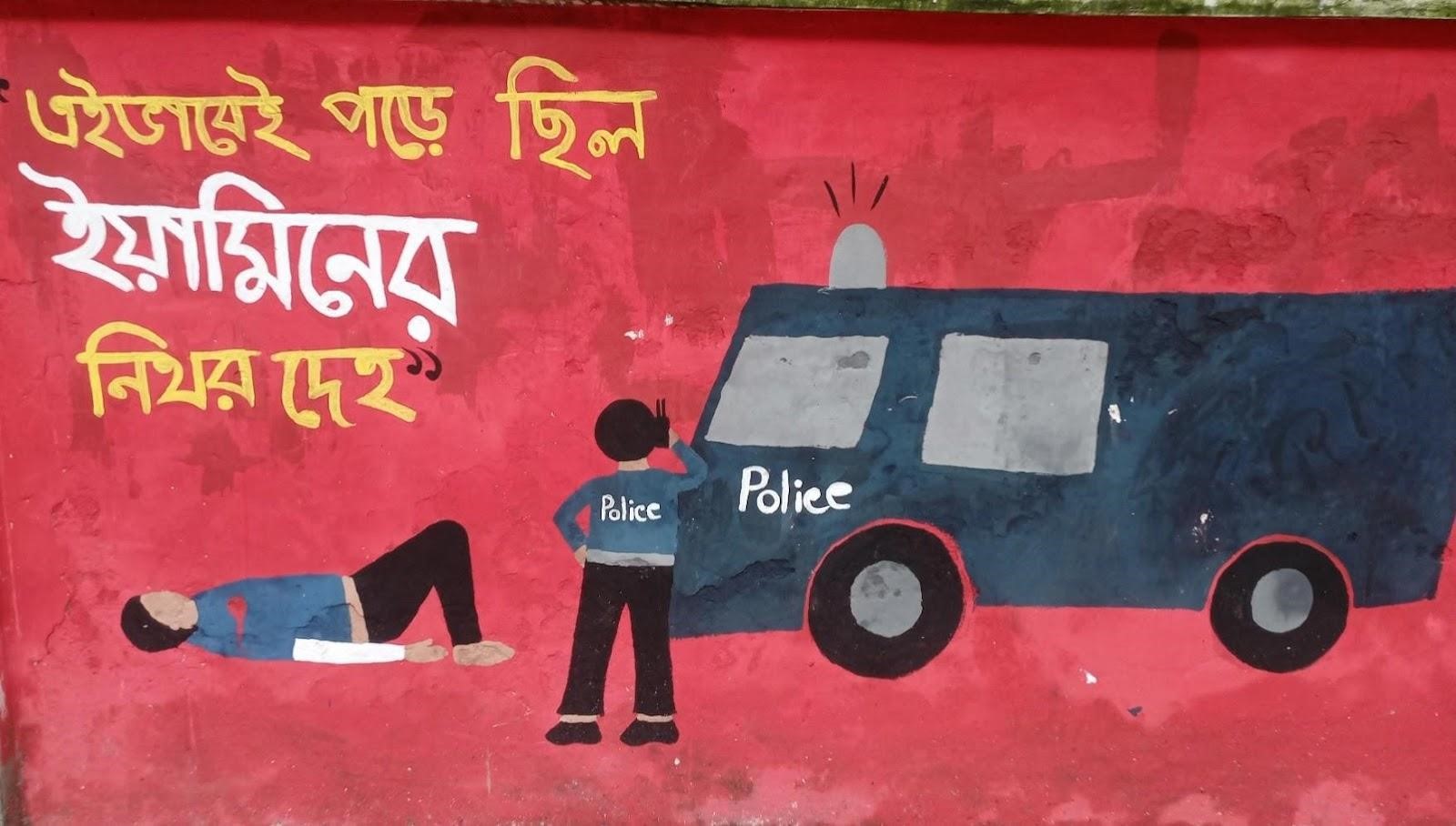
It
was 23-year-old Shykh Aash-Ha-Bul Yamin
- a computer science and engineering student at the Military Institute of
Science and Technology (MIST). On 18th July, as the police shot at protesters
in Savar, Yamin chose not to flee. Instead, in an extraordinary act of courage,
he scaled an armored police van. The police, in response, shot him at close
range, dragged his injured body down and threw it to the ground, discarding him
like a lifeless object.
A video capturing these harrowing moments surfaced days after Yamin's death, showing his body clinging to life, yet abandoned by those who were meant to protect. Yamin's death struck a chord across the nation, leaving behind a legacy of bravery in the face of brutality.
Yamin’s courage is now carried on by the walls of Bangladesh. His face, immortalized in graffiti, stands as a testament to his fearless resistance.
The walls tell his story—of a young man who refused to bow to oppression, whose spirit lives on through the vibrant colors and bold strokes of street art. These murals not only honor his memory but inspire countless others to continue the fight for justice, yet serve as a harrowing reminder of the defense forces’ brutality against unarmed young students.
Golam Nafiz
The walls remembered some forefront heroes as well, especially those who were left unsung. Here is the illustration of Golam Nafiz, a 17-year-old student, who got shot during a clash related to the quota reform movement.
Police had laid Nafiz on the footrest of a rickshaw, he clung to the frame with one hand, to take him to a hospital at Farmgate but they were obstructed by several Awami League leaders. Undeterred, the rickshawpuller redirected the rickshaw towards Khamarbari with Nafiz still in critical condition.
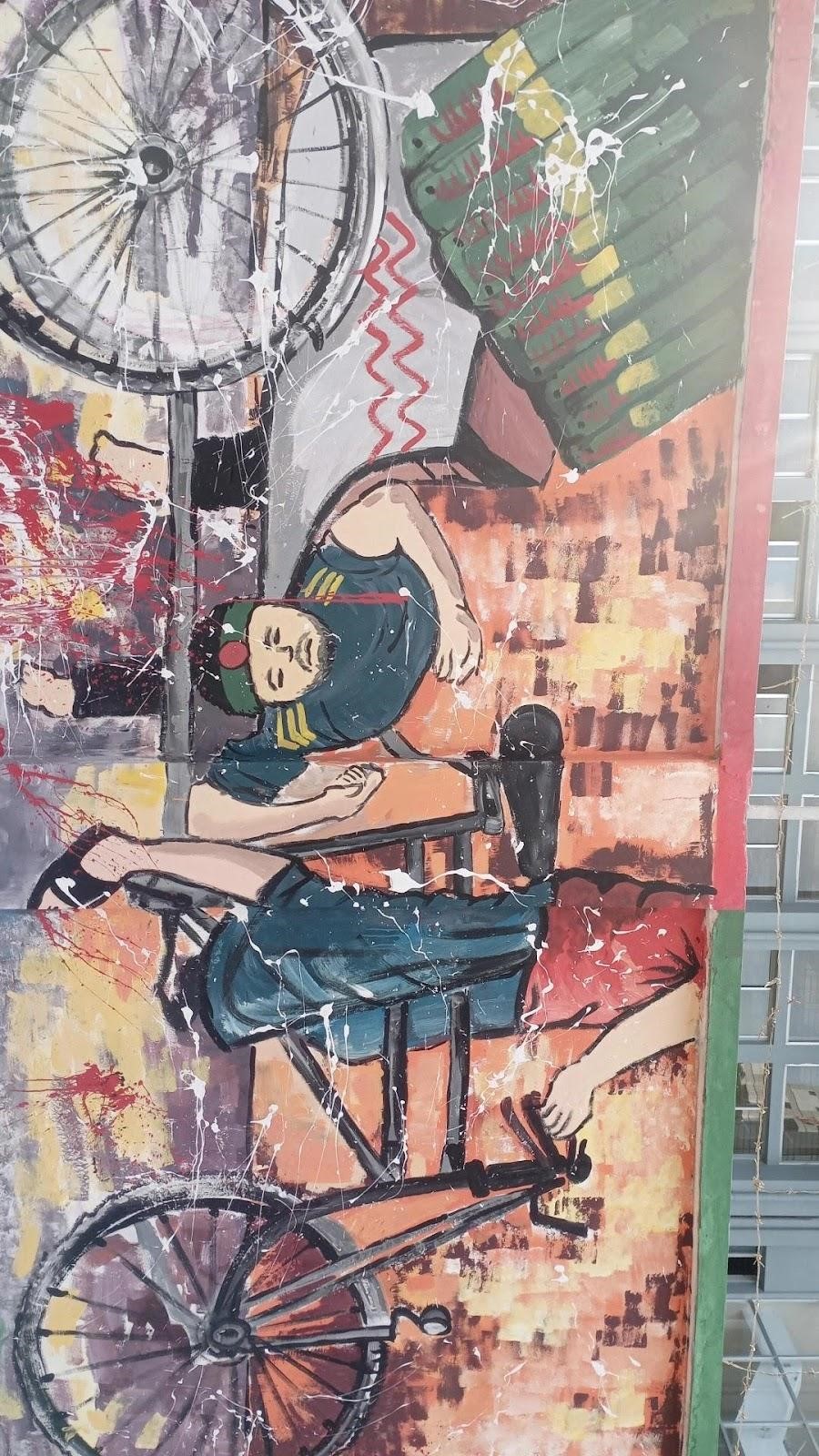
Photojournalist
Jibon Ahmed from the Daily Manab Zamin managed to capture images of Nafiz
hanging from the rickshaw. One of these photos, published on the front page of
the newspaper, went viral on social media after midnight on August 4. With the
help of the photograph, Nafiz's parents were able to locate his body. Both -
the parents and Jibon Ahmed - expressed regret, believing that Nafiz might have
survived if he had received medical attention sooner.
Tracks of Resistance in Graffiti
Using lyrics in graffiti has served particularly during periods of political tension and social unrest by providing a relatable narrative that resonates with individuals experiencing injustice.
By transforming lyrics into visual art on public walls, artists effectively communicate their grievances and solidarity, amplifying their message in a way that transcends traditional forms of protest. This practice not only substantiates the discourse around political issues but also reinforces cultural identity in the face of oppression.
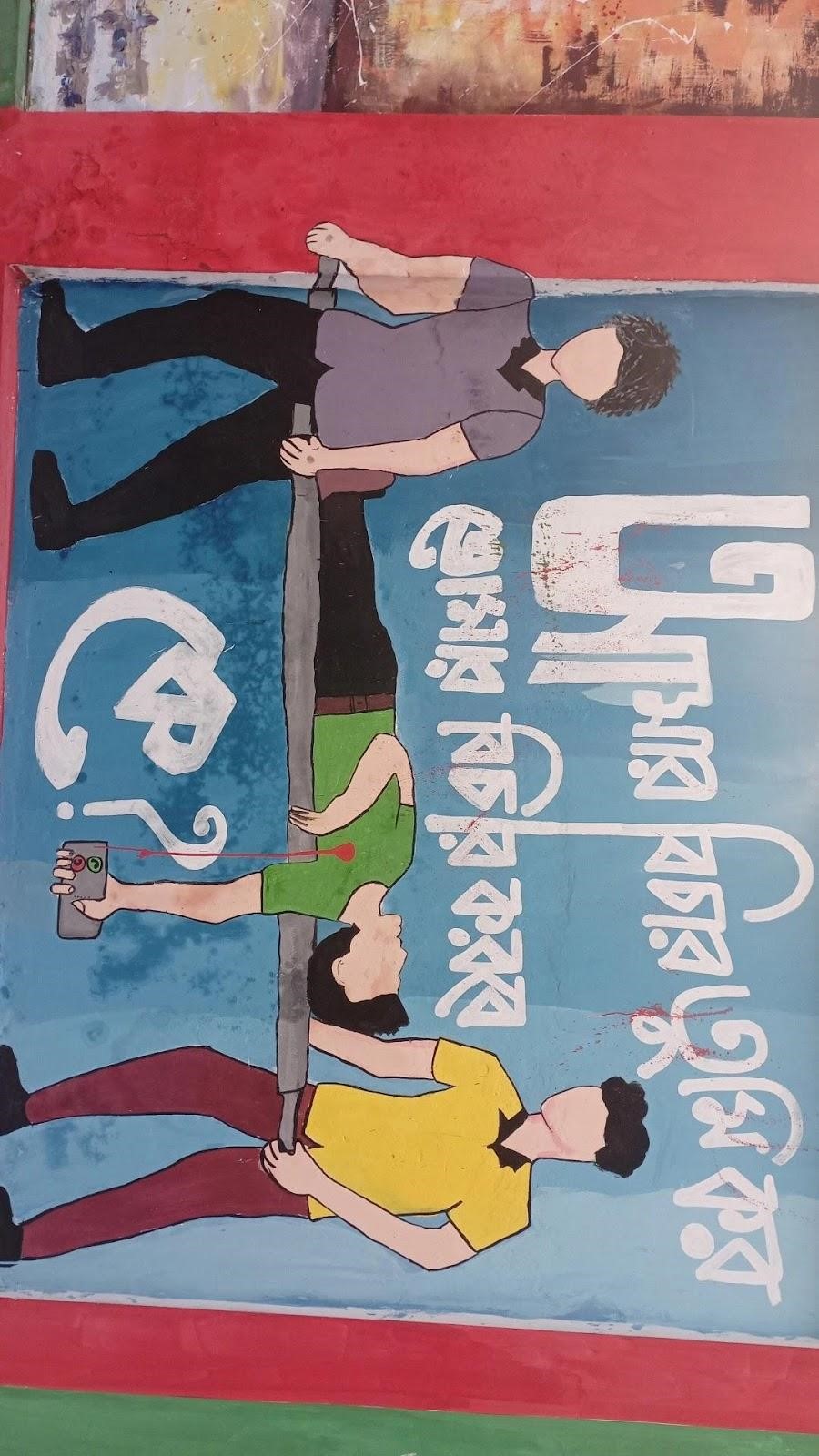
“আমার বিচার তুমি কর, তোমার বিচার করবে কে?” is one of the most famous and used lines during the anti regime
movement, taken from Shunno's song "Shono Mohajon".
This song, despite not being written with any political intent, found new significance during the recent anti-discrimination student protest.
Originally a general critique of power and oppression, it deeply influenced the protesters, becoming a powerful anthem against corrupt governance. The song, which had been part of the band’s earlier work, was widely used in social media reels in documenting the protests, amplifying its message and giving it renewed prominence as a voice of resistance.
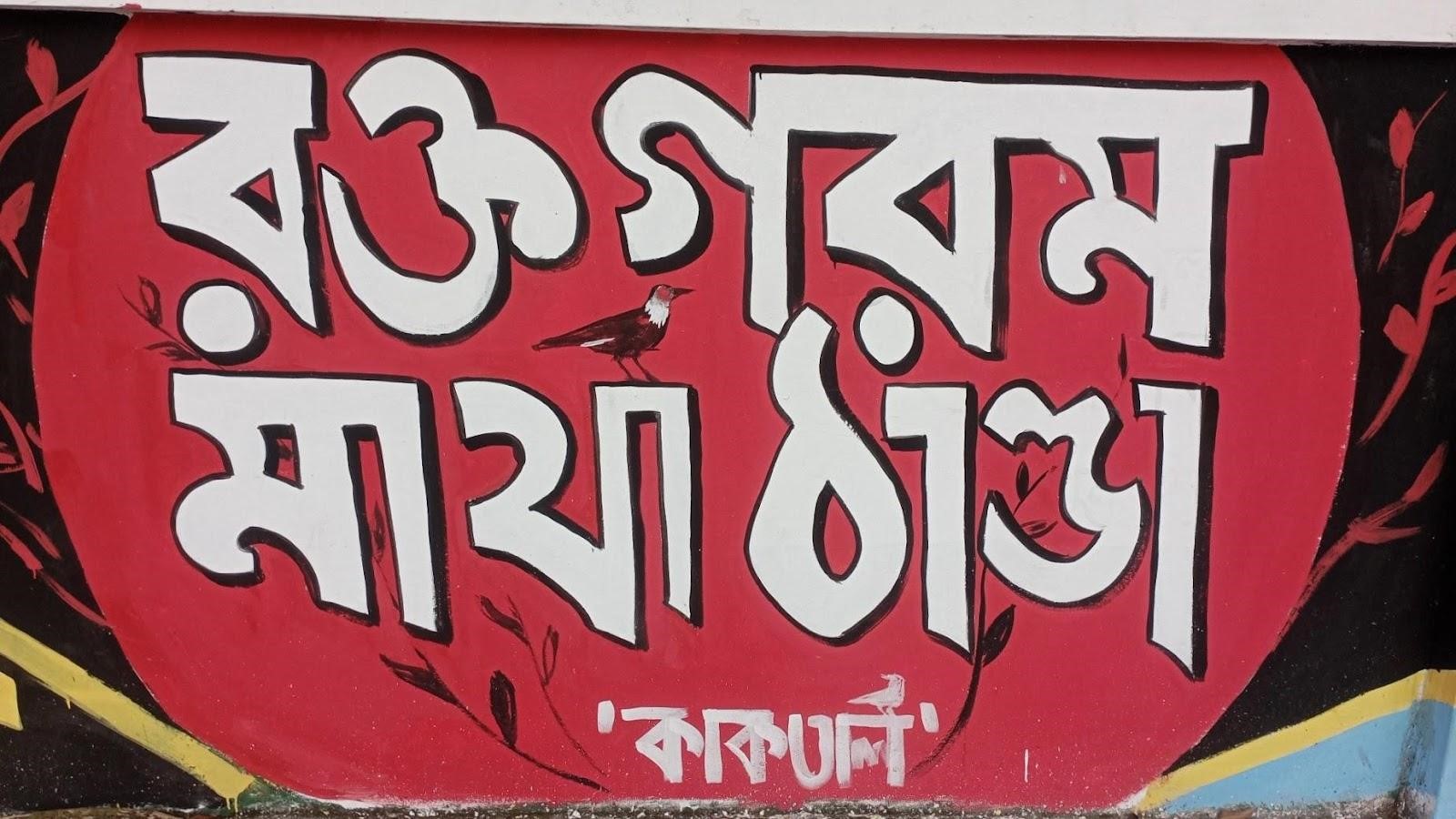
Lyrics as graffiti to express resistance is
not a new phenomenon. However, during the anti-discrimination protests and the
call for Hasina's resignation, songs—both new and old—became powerful symbols
of protest.
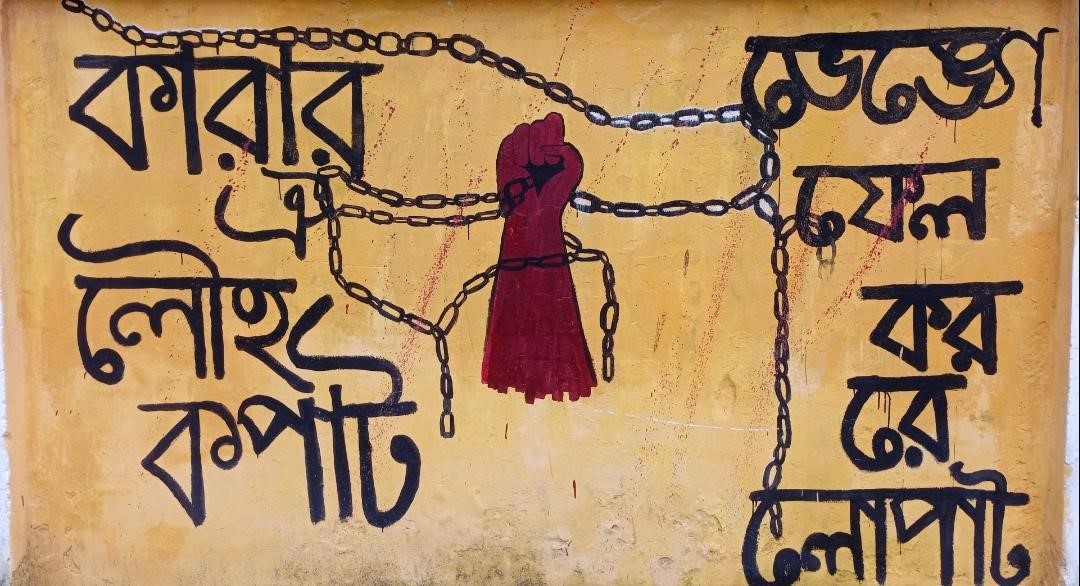
Besides,
tracks like "Shono Mohajon," Kazi Nazrul Islam's "Karar oi louho
Kopat," and Kaktal’s fiery "Rokto gorom Matha noshto"
transformed into the language of rebellion; with their words vividly displayed
on walls to amplify the collective voice of the tortured.
Media Coverage
The graffiti on walls during the anti-discrimination student protests served as a powerful reflection of public sentiment towards prominent news media and their coverage. Throughout the protests, many people in Bangladesh struggled to access authentic and uncensored information, especially during the internet shutdown.

In
this challenging environment, Jamuna TV emerged as a symbol of trustworthy
journalism. Many walls were painted with its logo, representing the citizens'
faith in the channel's detailed coverage; which stood in stark contrast to the
perceived biases of other media outlets.
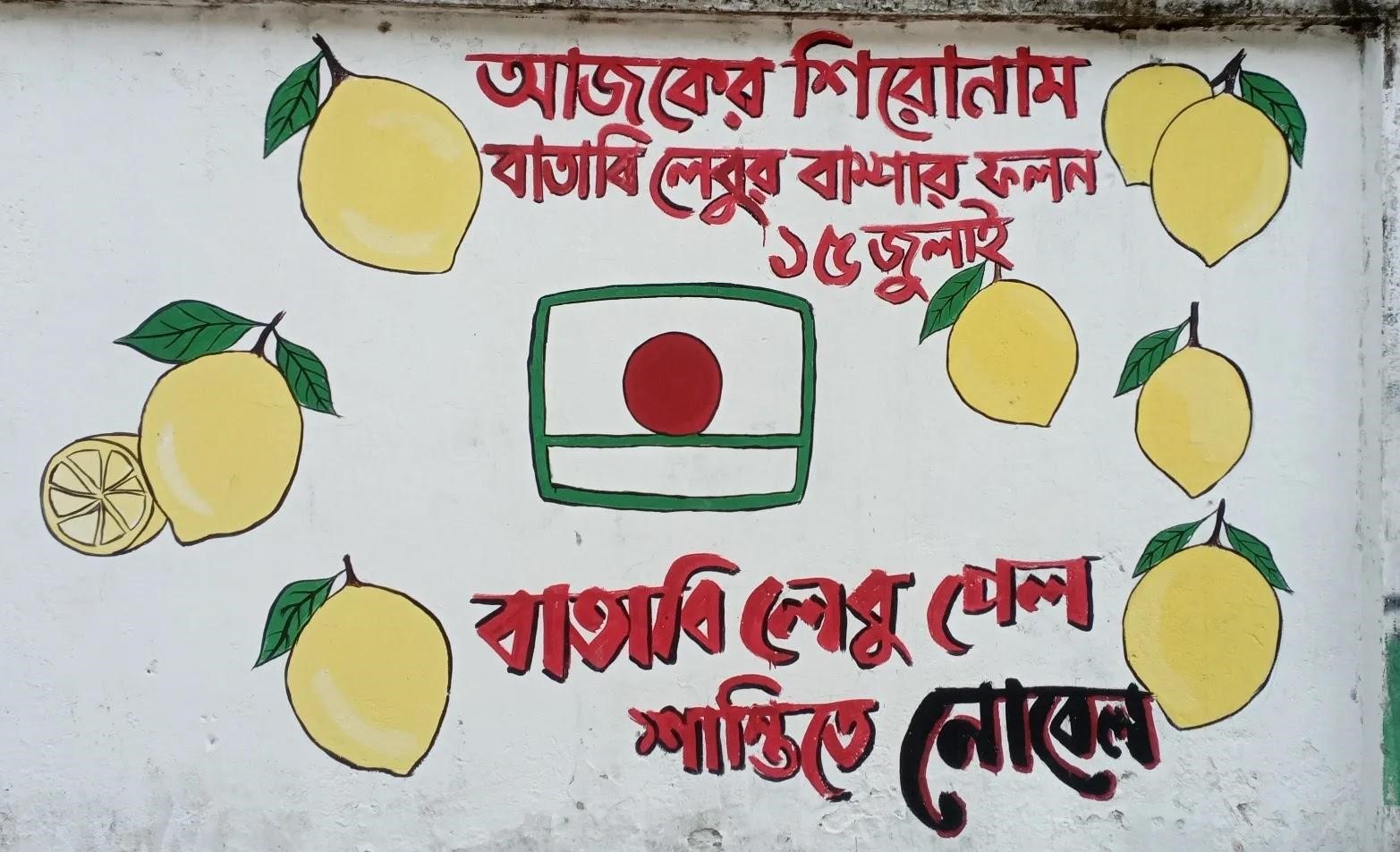
In
contrast, the national government channel BTV faced widespread criticism for
its handling of the unrest. While protests intensified, BTV continued to air
musical shows and agricultural awareness programs; neglecting the gravity of
the situation.
This disconnect between the channel's programming and the public's demand for truthful reporting fueled anger among protesters. As a result, graffiti emerged not only as a form of protest but also as a commentary on media inadequacies, with artists expressing their disillusionment and demanding accountability from BTV and other outlets.
The frustration culminated in an attack on the BTV headquarters on July 18th, highlighting the growing unrest and the urgent call for genuine media representation.
Internet Shutdown
The walls also became a canvas for illustrating the Awami regime's control over basic rights, particularly the right to access information. During the protests, nearly all media outlets and newspapers, with a few exceptions, displayed bias in their coverage.
As a result, many turned to independent journalism - relying on videos and posts circulating on Facebook and Twitter for accurate information. This shift highlighted the regime's atrocities and police brutality, making social media a crucial platform for exposing the truth.
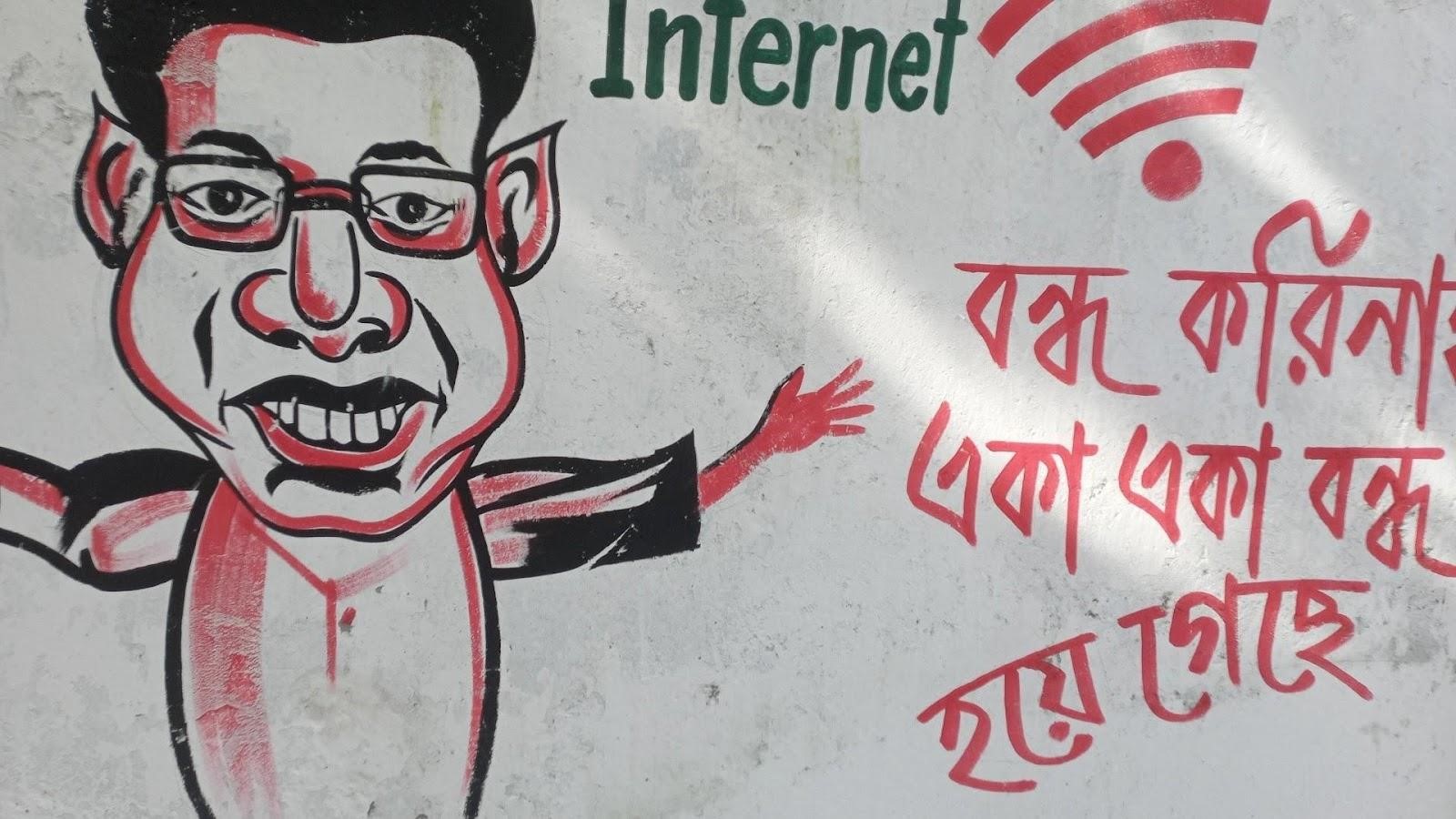
From
July 14 to August 5, internet users in Bangladesh faced significant challenges.
The internet was completely shut down for more than five days, effectively
disconnecting the country from the rest of the world. Many social media
platforms remained blocked for extended periods during this time. Zunaid Ahmed
Palak, the former state minister for ICT, initially claimed that the internet
shutdown was due to the widespread spreading of rumors.

He
later attributed it to a fire incident at data centers in Dhaka's Mohakhali,
which damaged the telecommunications infrastructure and was allegedly caused by
miscreants. Eventually, he stated that the government did not intentionally
shut down the internet; rather, it occurred automatically.
The internet blackout in July is estimated to have cost the tech industry around $300 million, severely damaging the outsourcing sector and highlighting the broader economic implications of restricting access to information.
Aynaghor/ House of Mirrors
The fall of Awami regime has given way to expose all those concealed secrets regarding the disappearance of anti-government activists, along with giving artists the freedom to uphold the truth as well.
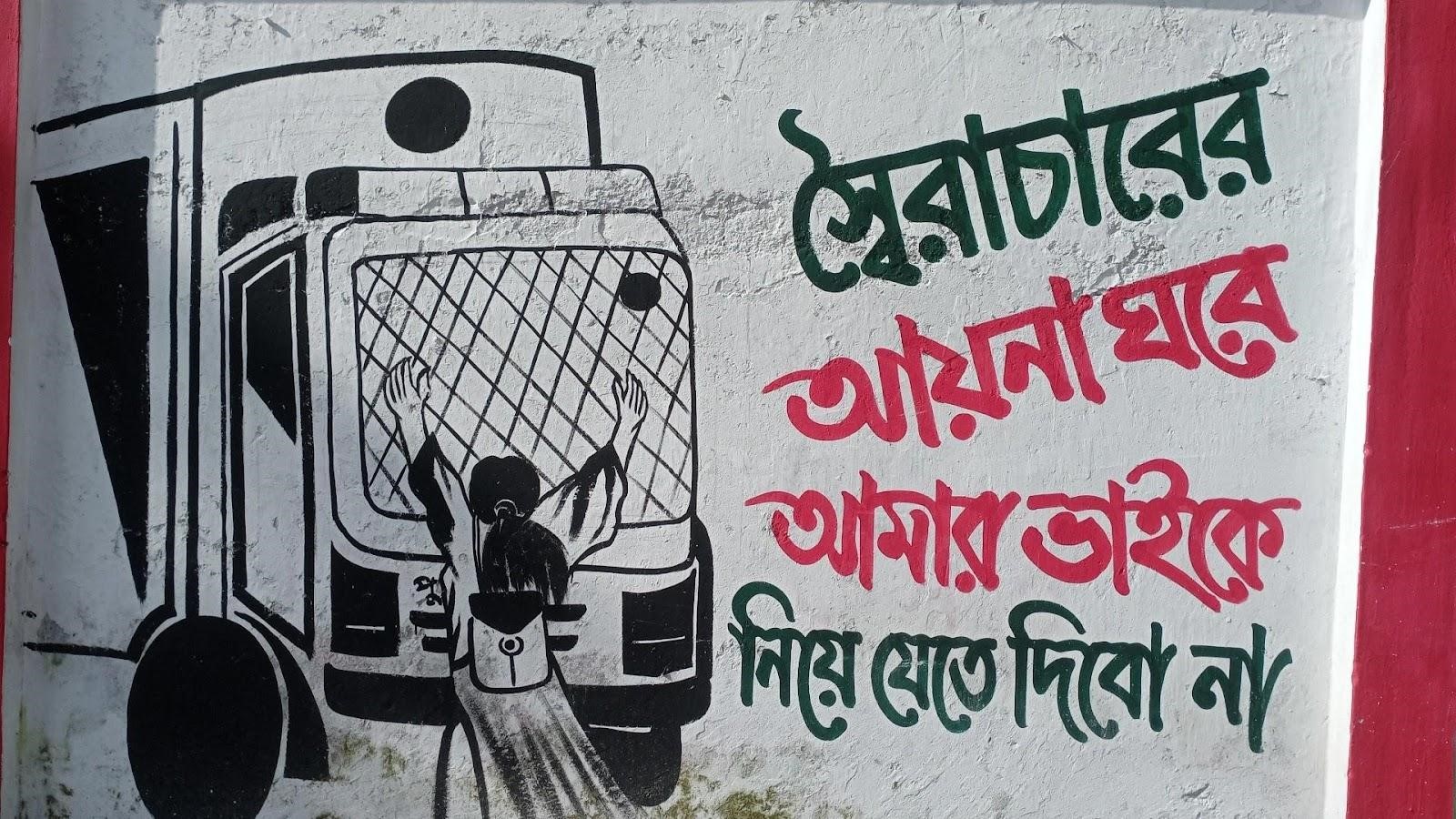
Rumors
have circulated about the existence of Aynaghar, or "House of
Mirrors," a secret prison in Bangladesh operated by the Directorate
General of Forces Intelligence (DGFI) under Sheikh Hasina's government.
On August 14, 2022, Netra News, a Sweden-based independent news portal, published an investigative report alleging that Bangladeshi officials were detaining and torturing victims of enforced disappearances at this facility.
Yet people not having concrete evidences, until the release of the captives, could not speak out against the detention camp. However, for the very first time, the walls in the nation captured the graffiti, standing against the legitimacy of extra judicial punishments– like Aynaghor.
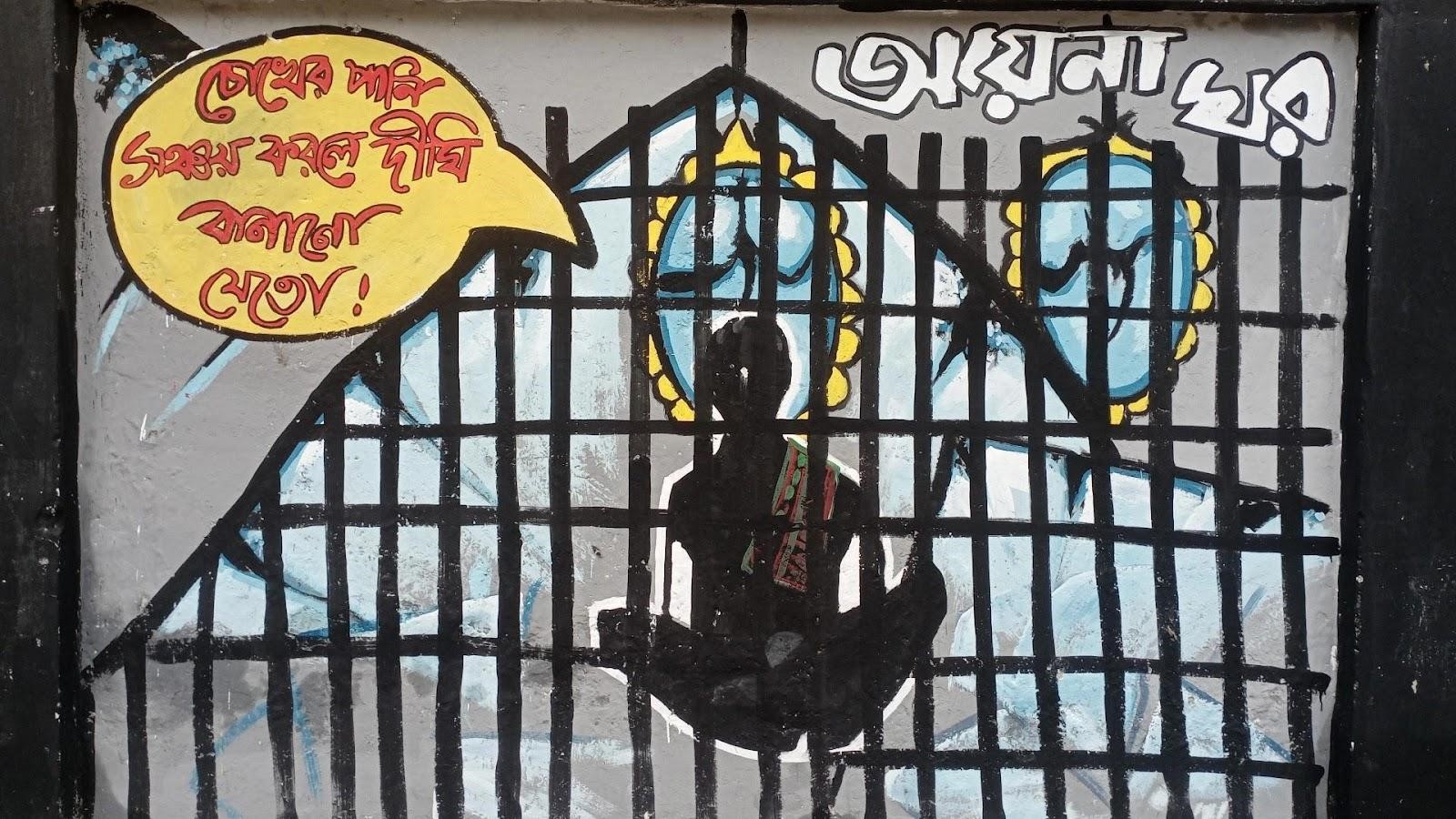
The
report identified a possible location for Aynaghar in central Dhaka, drawing on
the firsthand accounts of two victims - Hasinur Rahman and Sheikh Mohammad
Salim - who described their experiences within the prison. The investigation
also included photographs of the prison cells, reportedly supplied by
active-duty military personnel.
Since 2009, rights groups in Bangladesh have documented around 600 cases of alleged enforced disappearances - a tactic the government has been accused of using to suppress dissent. Some victims have been released or presented in court, while others were found dead. According to Human Rights Watch, nearly 100 individuals remain missing, despite the government's denials of these allegations.
How many bullets does it take to kill a person, sir?
This quote has been prominently featured in graffiti throughout the city, serving as a powerful reminder of the human cost of political unrest. Graffiti artists have chosen to highlight Moynal's anguished words to emphasize the brutality of state violence.

One poignant quote resonates deeply amidst the
grief, like when grief stricken SI asks after losing his
17-year-old son,Imam Hossain Tayeem in Jatrabari clash.Tayeem had left
home to participate in the quota reform protests at Rayerbagh, Jatrabari, which
had recently become a hotspot for violent clashes.
An hour later, his parents received a distressing call which informed them that Tayeem had been shot and was en route to Dhaka Medical College Hospital (DMCH). Upon discovering his lifeless body, his father - Moynal - was heard on the phone, heartbreakingly stating, "Sir, my son is dead. His chest was torn apart by bullets." It was not confirmed who was Moynal asking this to.
From 1971 to 2024
In 1971, Bangladesh fought for liberation from Pakistani dominance, a year that marked the struggle for independence. In 2024, the anti-discrimination student protests, which evolved into a widespread movement against Hasina's dictatorship, echoed the sentiments of the liberation war.
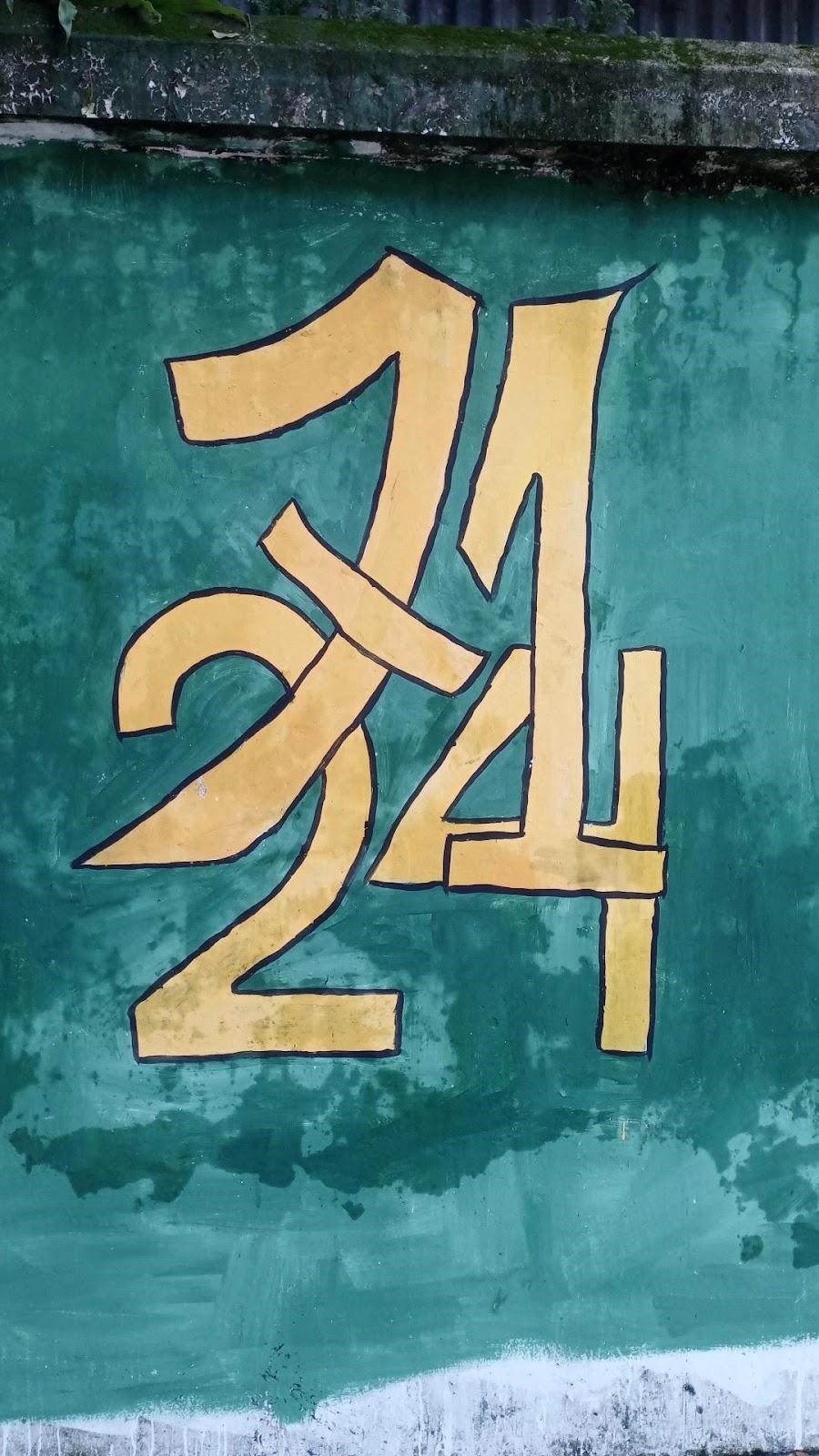
Graffiti
from this period depicts the parallels between the past and present. For
instance, it portrays the Pakistani army asking if there are any freedom
fighters at home, mirroring the raids conducted by the RAB, police, or BGB in
search of students or alleged protesters.

These
similarities highlight the ongoing struggle against tyrannical rule and the
fight for rights and independence. It has been said that while 1971 gave birth
to Bangladesh, the events of 2024 represent the emergence of a new, Bangladesh
2.0
Helicopter shooting
The walls are adorned with haunting graffiti that captures one of the most horrifying atrocities committed by the defense forces. One piece depicts a young child joyfully watching a helicopter, only to be met with the grim reality of it firing upon her.
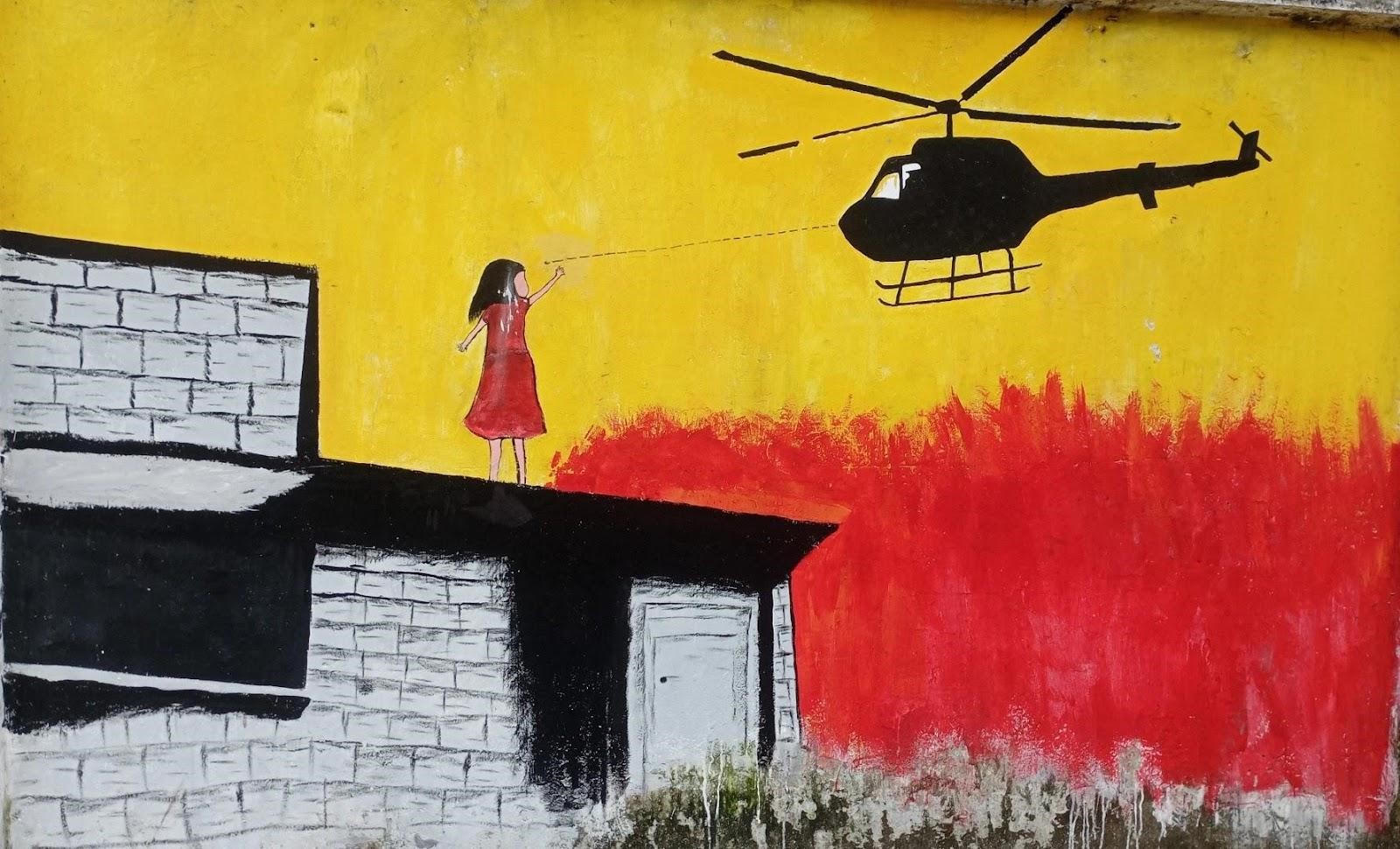
The
protesters soon reported that the bullets were fired from the helicopter. In
the following days, multiple incidents of gunfire from helicopters occurred in
various parts of Dhaka and Narayanganj, resulting in numerous casualties.
The Rapid Action Battalion (RAB) has denied these allegations, asserting that their air wing chopper only deployed gas and sound grenades to facilitate the movement of law enforcement personnel and protect lives and property. Despite their claims, the deaths of at least 10 children have been attributed to the helicopter shootings - underscoring the tragic impact of this violence.
Captivated Coordinators
The graffiti highlights various issues associated with the Awami regime's political climate, including abduction, coercion to make statements, blackmailing, misleading protesters, and the pervasive atmosphere of fear under the said regime. These elements collectively portray a chilling picture of the government's tactics to suppress dissent and maintain control over the forefronts of the protests.
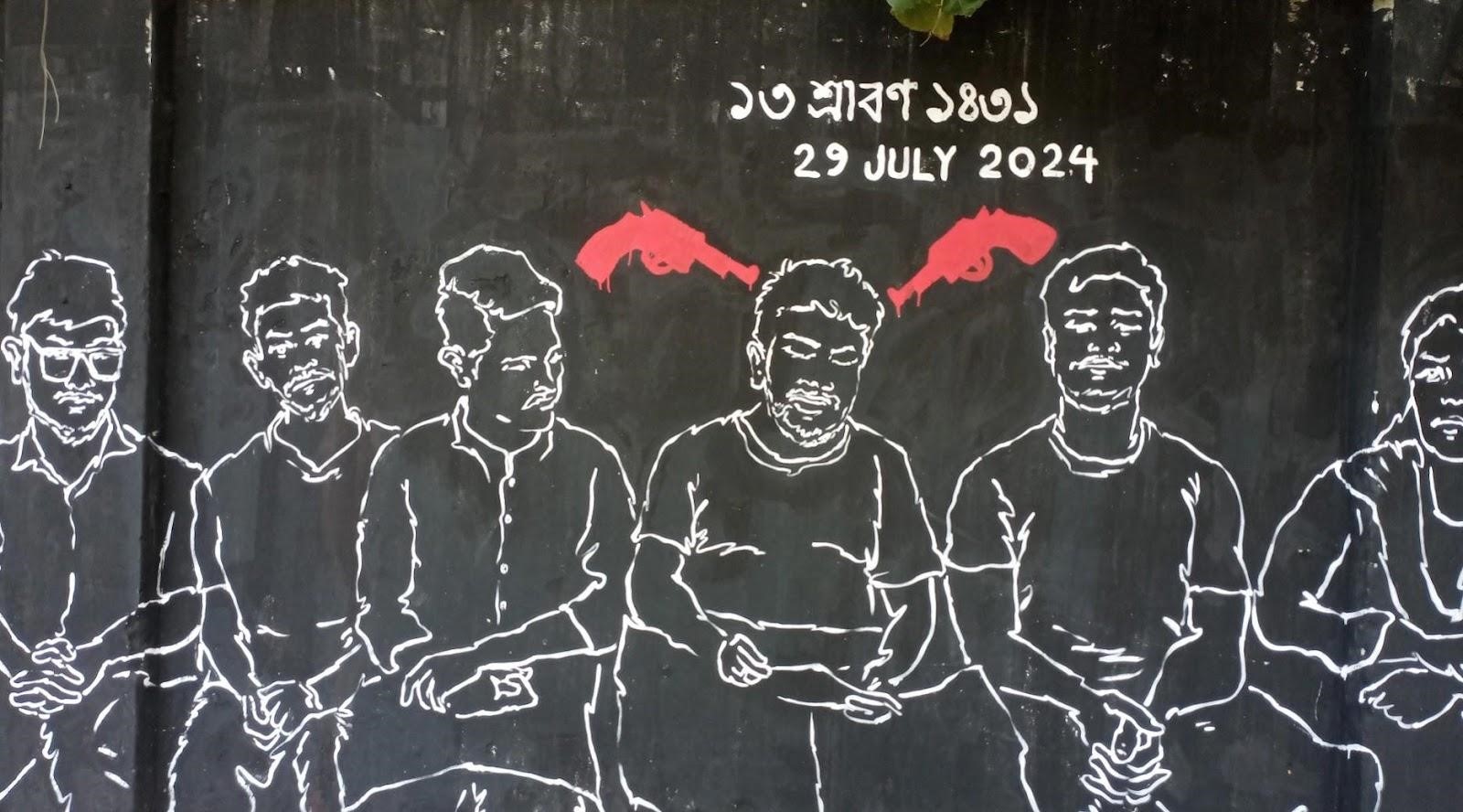
On
July 28th, 6 main coordinators of the protest movement called the protests off,
however claiming on 2nd August that they were unjustly detained and mistreated
by law enforcement at the Detective Branch (DB) office.
They recount being forced to sit at a dining table while being filmed, and their families were made to wait for 13 hours under the false assurance of their release. The coordinators, including Nahid Islam, Asif Mahmud, and Abu Baker, initiated a hunger strike on July 30 to protest their wrongful arrest and the torture of students nationwide.
They had alleged that their detention was ordered by the former home minister and claimed that the government was instigating violence against students and citizens alike, thereby obstructing peaceful protests.
The statement details the timeline of their arrests, noting that Nahid and Asif were picked up from a hospital, while other coordinators were forcibly taken from different locations.
Silencing the protesters
The graffiti illustrates the stark reality of limited or nonexistent freedom of expression and suppressing the little amount Sheikh Hasina's tyranny offered.. It captures a moment from the "March for Justice" during the anti-discrimination student movement on July 31, when Inspector Arshad Hossain attempted to silence Nahidul Islam - a student from the Political Science department of Dhaka's New Model Degree College - by placing his hands on Nahid's face.
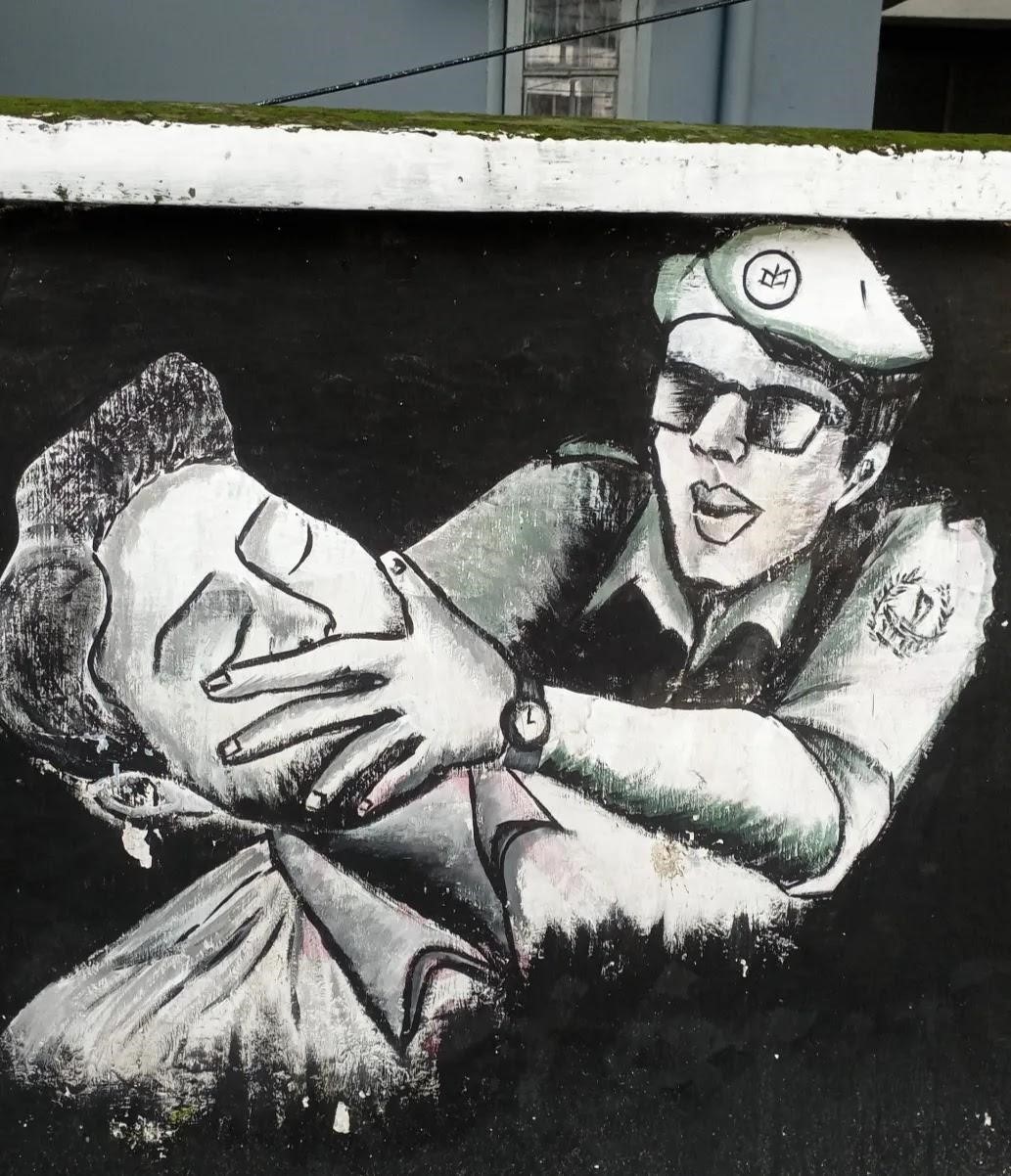
As
the anti-discrimination movement was against of all the discrimination against
all categories of citizens, Graffiti artists remembered to address tea workers
rights, that got suppressed with their rights for appropriate age board, demand
recognition of their rights, addressing not only the economic injustices they
face but also the broader struggles against discrimination and inequality in
society.
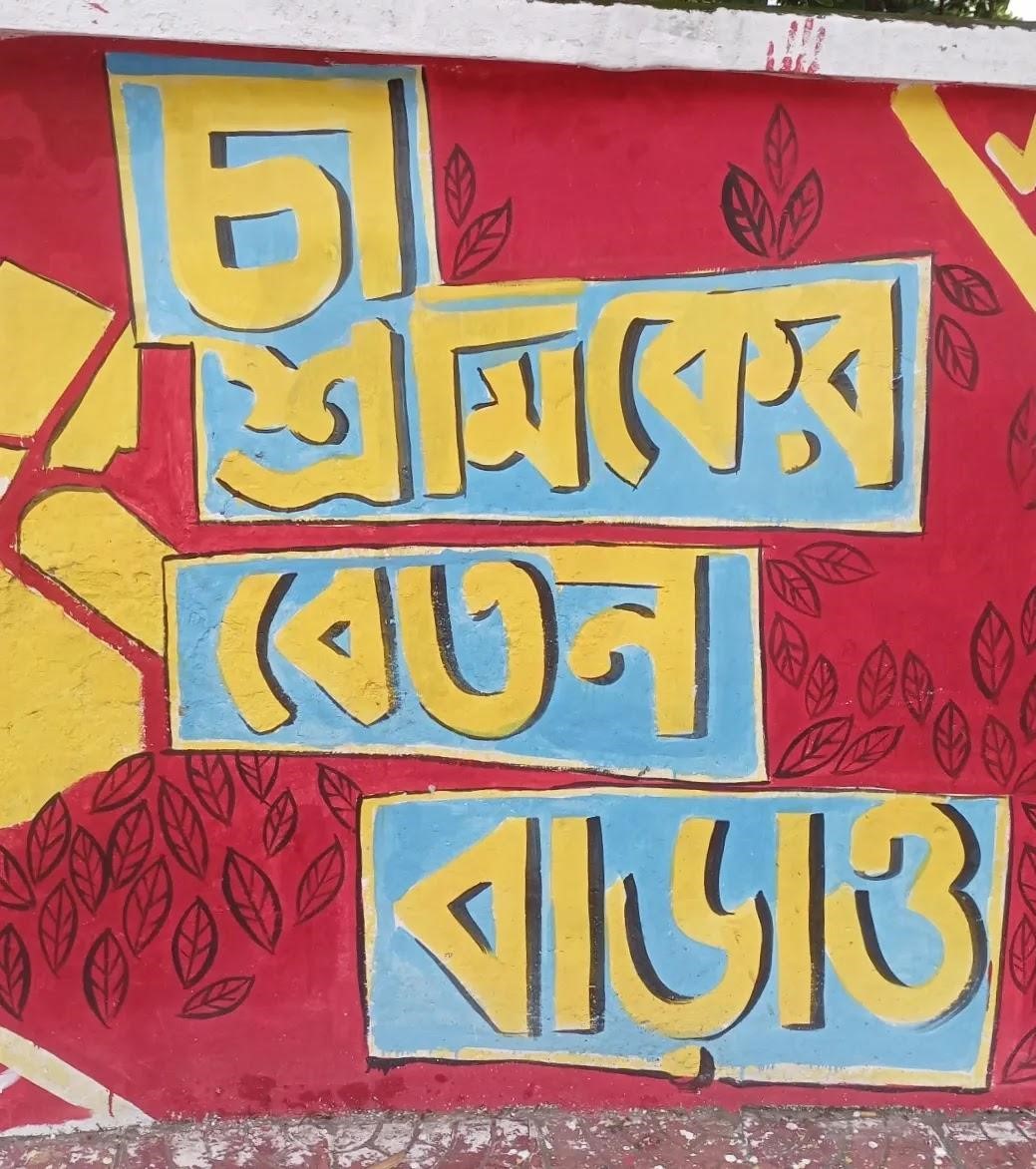
This wage disparity is exacerbated by poor
working conditions, lack of job security, and limited access to vital services
like healthcare and education. In August 2022, then Prime Minister Sheikh
Hasina directed tea estate owners to increase wages from Tk 120 to Tk 170 in
response to widespread protests in the gardens. However, the wage board has
failed to provide acceptable recommendations for a sustainable wage structure
for tea workers.
Understanding GenZ protestors
Generation Z, known for its reliance on technology, has consistently been evaluated by previous generations on their effectiveness and strategies in handling national crises.
Fast forward to 2019, when protesters in Hong Kong took to the streets in a new wave of mass anti-government demonstrations amidst ongoing political unrest, utilizing flash mob tactics to evade police, these young activists showcased their resourcefulness and adaptability in the face of repression.
Similarly, in Kenya, Gen Z, which comprises about 33% of the population, is leading the charge against the proposed Finance Bill 2024, rallying under the hashtag #RejectFinanceBill2024. This socially conscious generation is passionate about enacting positive change and is actively protesting against punitive tax measures they believe will worsen their financial struggles.
Both movements highlight Gen Z's commitment to social justice and their ability to mobilize and advocate for their rights in innovative ways.
The youth of Bangladesh demonstrated their resilience and ingenuity during the 2024 anti-discrimination student movement, which began as a protest against discriminatory job quota categories. Generation Z leveraged technology effectively to participate in the protests, both online and offline.
They rapidly disseminated news and information, coordinated assistance, called for ambulances, and provided on-the-ground support to those in need.
A notable strategy was their shift to various social media platforms such as Twitter, Reddit, Discord, and Snapchat to capture international media attention and communicate more securely. During internet shutdowns, many students employed VPNs to bypass restrictions, while others set up temporary communication and news servers to stay connected without broadband access.
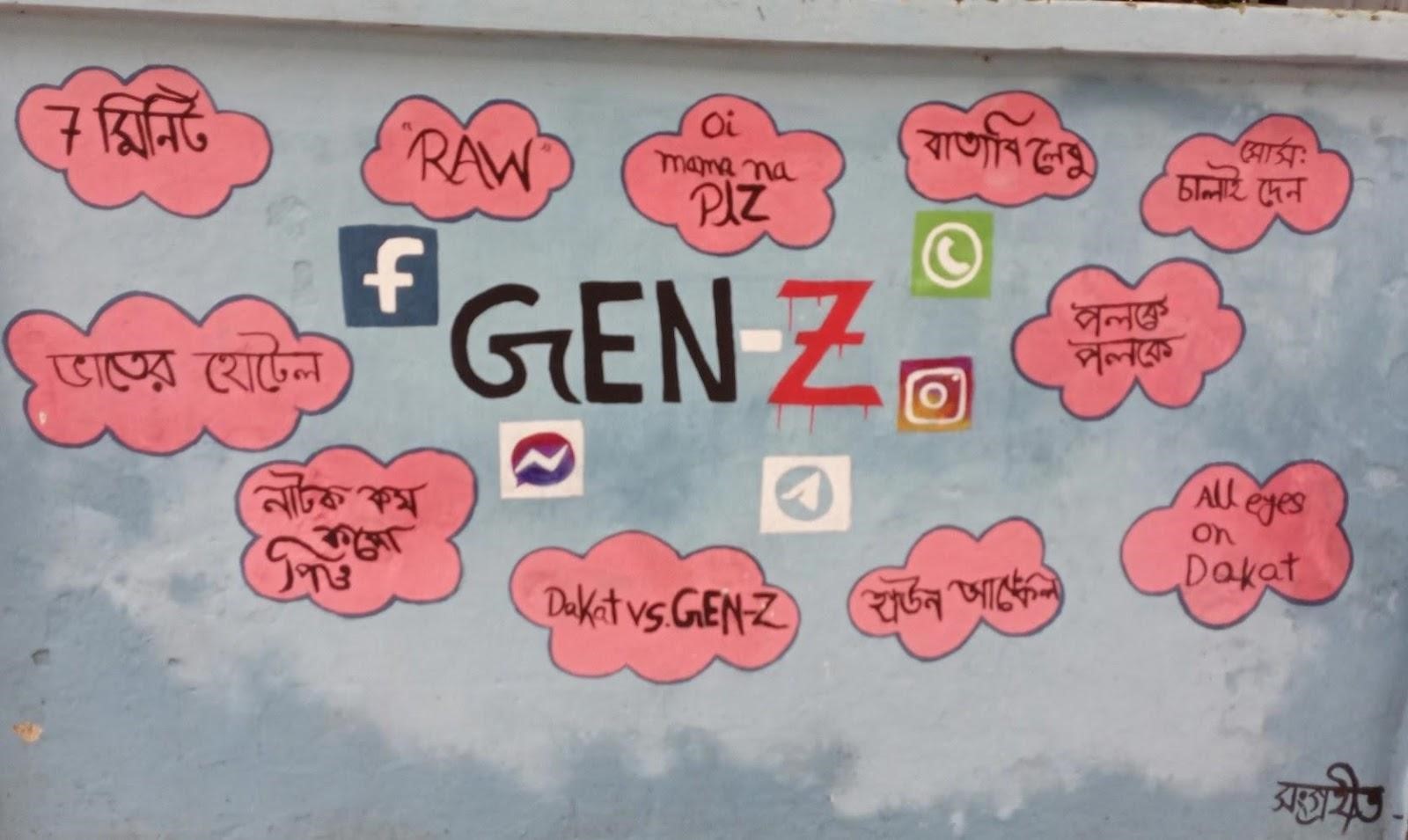
Gen
Z's mastery of technology allowed them to challenge authoritarian rule so
effectively that the government felt compelled to shut down the internet on
select days to disrupt their organizing efforts.
What began as a youth-led protest evolved into a broader movement advocating for the rights of all citizens, with many young people sacrificing their lives for the cause.
Their efforts underscored the power of technology in modern activism and the determination of a generation to fight for justice and equality.
The protests that began with Bangladesh's youth transformed into a broader movement for citizens' rights, with many young people sacrificing their lives for the cause.
Following the downfall of Sheikh Hasina's rule, even in the absence of an interim government, Gen Z youth stepped up to protect minorities, their homes, and places of worship. They took it upon themselves to manage traffic, patrol neighborhoods overnight to deter looters, and hold them accountable when police were unable to fulfill their duties.
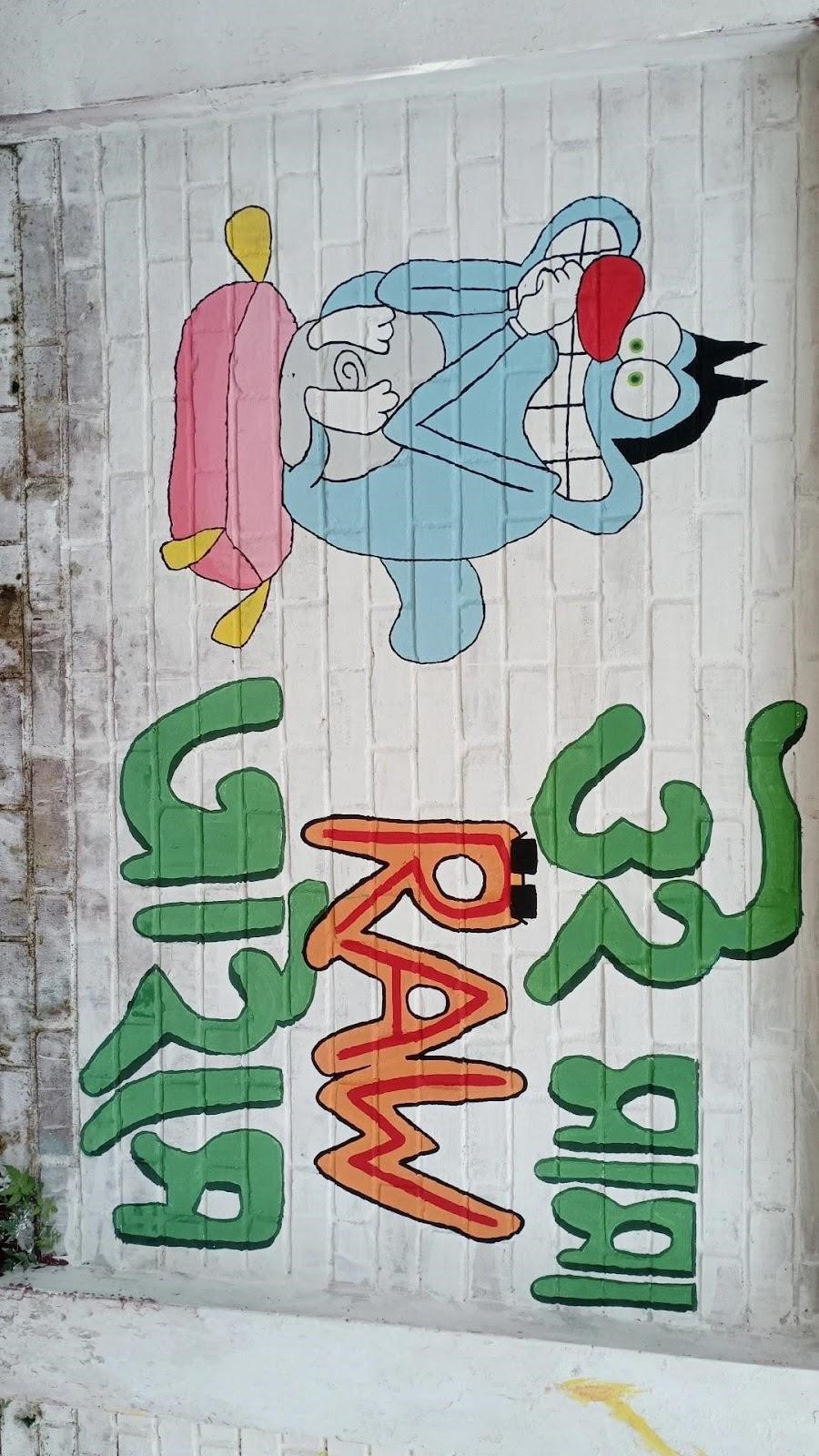
In
the wake of this year’s deadly floods, the Gen Z youth once again demonstrated
their commitment to their country by mobilizing to collect funds and relief
supplies, personally distributing aid to those affected.
The impact of the youth-led anti-discrimination protests has resonated beyond Bangladesh, inspiring movements for justice and equality across borders. Their determination and resilience have showcased the powerful role young people can play in driving social change and addressing pressing issues within their communities.
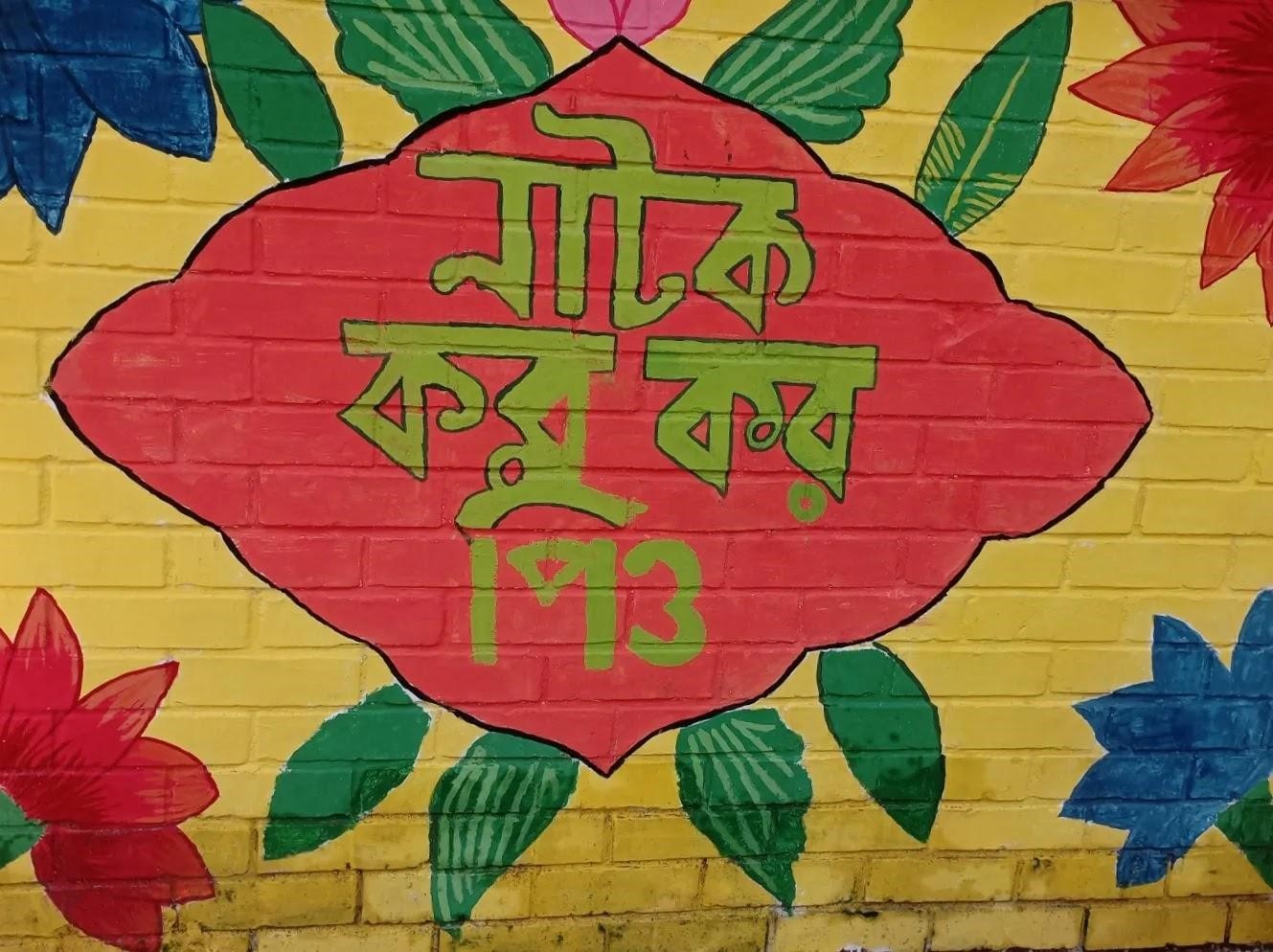
This
year, after the fall of the Awami regime, adding the flood calamities and
national unrest, Gen Z has gained huge
attention and appreciation for their active participation and contribution.
This is why, the Graffiti works this year, importantly prioritizes Gen Z theme
and events, which collectively made the protests successful.
This graffiti art showcases the participation and solidarity of rickshawpullers to the students. During the protest, to express solidarity with the students' protest, on 2nd August, rickshaw-pullers gathered on the road in front of the Central Shaheed Minar.
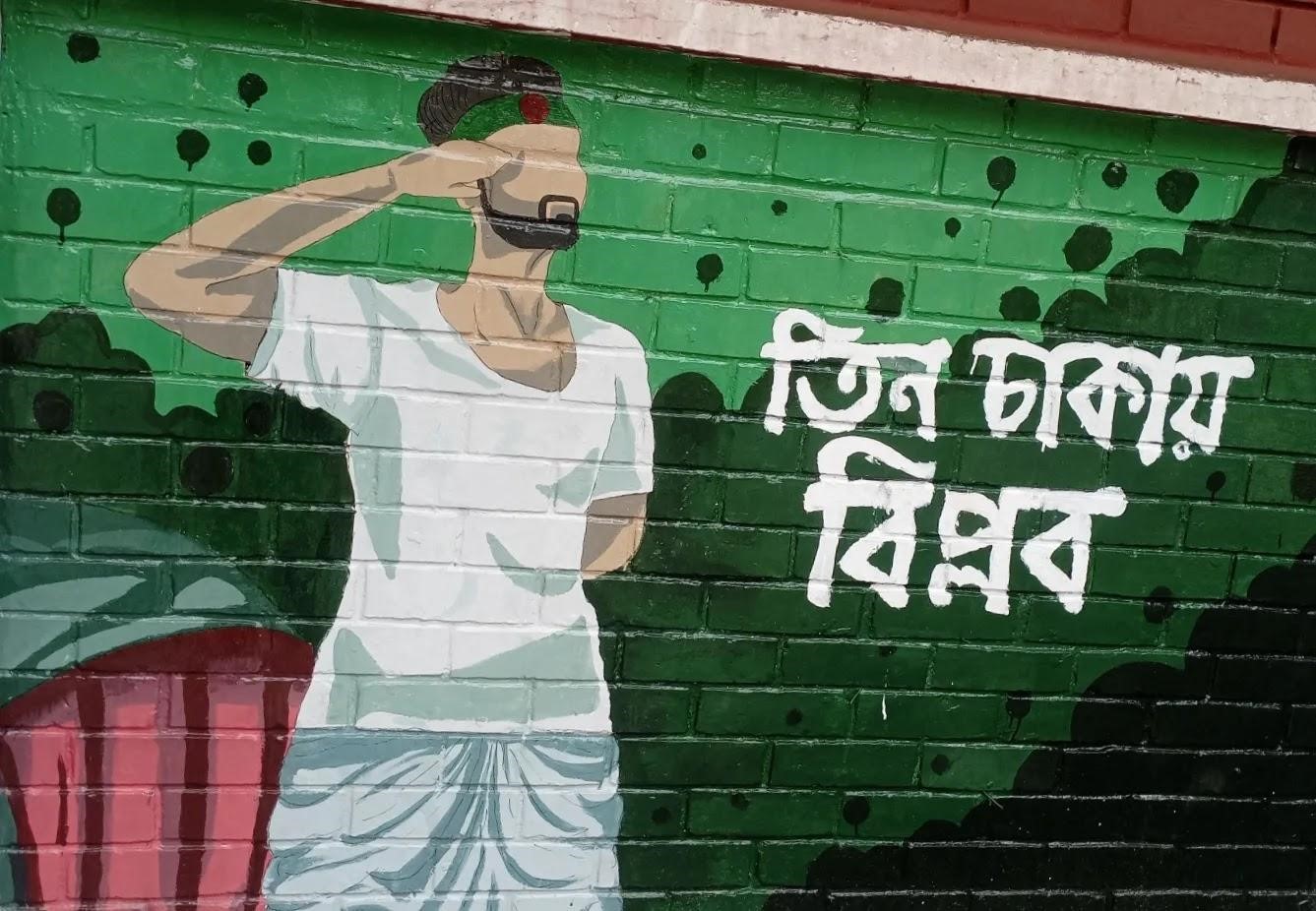
They
stopped their rickshaws, blocked one side of the road, and chanted slogans
asking the Sheikh Hasina-led government to step down immediately.
Particularly, this rickshawpuller shown on the graffiti gained mass attention; who was seen saluting as a procession of thousands passed by Doyel Chattar at Dhaka University.
The walls are also covered with quotes that goes “দেশটা কারোর বাপের না,” or “This state does not belong to anyone's father!”, a very much expressive rage against Sheikh Hasina's rationalising her dominance over Bangladesh and the citizens.
Because of the recognition of her father, as the founding father of Bangladesh, Sheikh Hasina often was alleged to misuse the privilege and legitimize her unauthorized power over the citizens as her right, since Sheikh Mujibut Rahman is said to be the one behind the independence of Bangladesh.
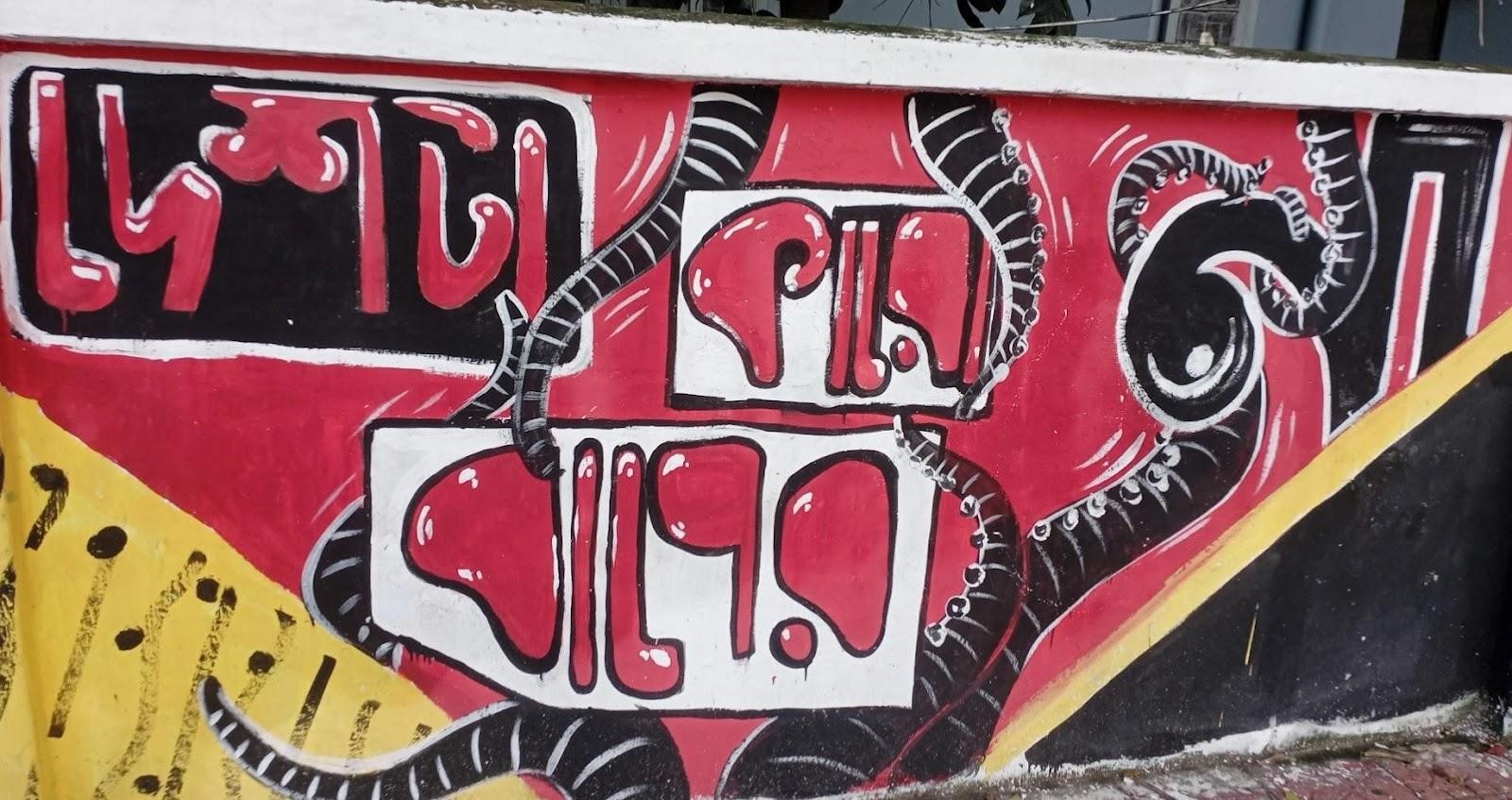
This
is why the graffiti are here to remind us that the state only belongs to it's
people. Not anyone else, not even to someone's father.
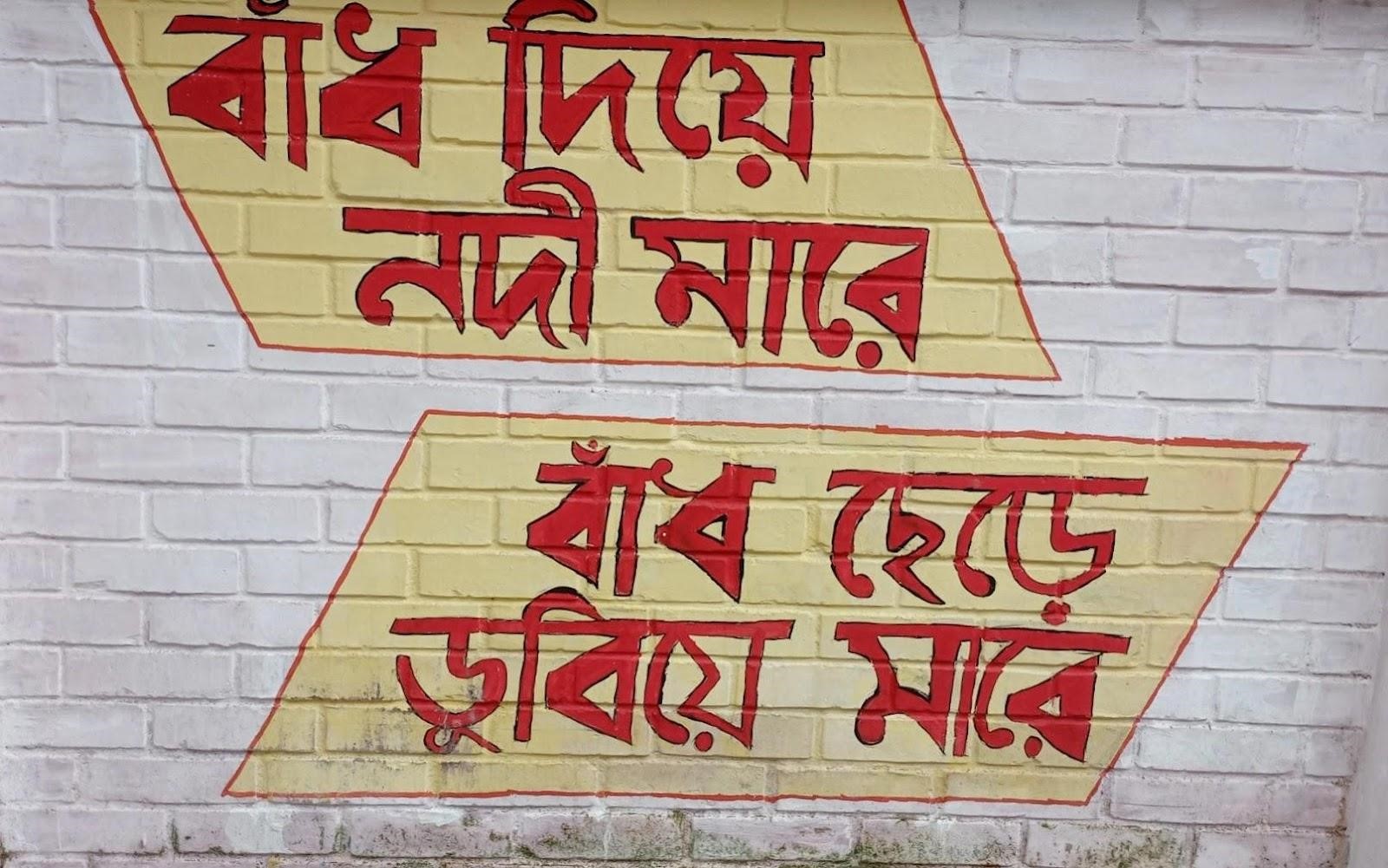
This
graffiti powerfully illustrates the long-standing water dispute between India
and Bangladesh, a conflict marked by India's unilateral control over dam
operations.
By keeping dams closed, India often causes severe droughts in Bangladesh, and during monsoon seasons, the sudden release of water results in devastating floods. These floods lead to widespread homelessness, destruction of crops, loss of land, and even loss of lives.
One of the most contentious aspects of this dispute is the Teesta River negotiation, which remains unresolved.
The uncertain outcome of this agreement has left Bangladesh in a vulnerable position, highlighting the ongoing struggle for equitable water sharing between the two nations. The graffiti reflects the deep frustration and suffering caused by this imbalance, capturing the essence of this critical issue.
This graffiti portrays a pivotal event in the history of Dhaka University. On July 15th, amidst nationwide protests that resulted in five deaths, the situation at Dhaka University escalated.
Students marched out of their halls, referring to the former prime minister as ‘Rajakar’, denouncing their regime. However, later that morning, the protesters were violently attacked by members of the Bangladesh Chhatra League (BCL), leaving many severely injured and disrupting the movement.
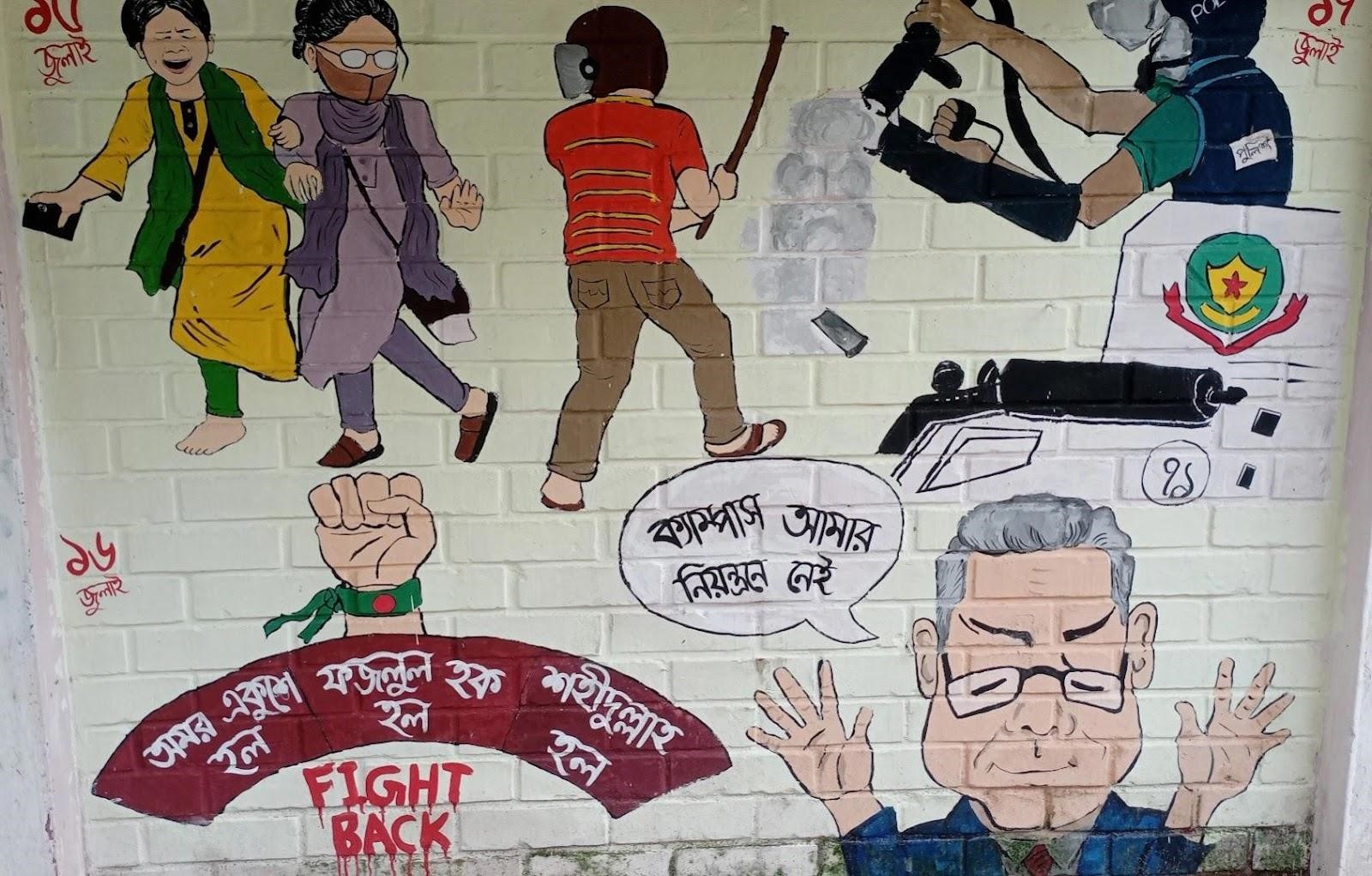
Despite
the violence, neither the university proctor, the police, nor the then
Vice-Chancellor Maksud Kamal took any action against the BCL for their attack
on the students. In response, later that night, students banded together and
forcibly evicted BCL leaders and workers from their halls.
On July 16th, as the protests continued on campus, police and Border Guard Bangladesh (BGB) forces launched an attack on the demonstrators, using tear gas and rubber bullets.
It was later revealed that VC Maksud Kamal had authorized the use of force, allowing the defense forces to "establish peace." By that evening, the university administration ordered the students to vacate their halls, marking a significant moment of repression in the university’s history.
==
Chapter TWO
How The Oppressed Sings: Rap Music of The Bangla Bashanta
Music has always been closely tied to movements and protests worldwide, serving not just as a rallying cry but as a unifying force for those resisting oppression.
It transcends slogans, bringing people together through a shared message of hope and bringing justice. Music doesn’t just accompany revolutions– it drives them, offering strength, solidarity, and a sense of identity to those fighting for change.
In Bangladesh, the bond between music and resistance runs deep. The Bengali Language Movement of the early 1950s gave rise to songs like Abdul Gaffar Chowdhury's "Amar Bhai er Rokte Rangano Ekushe February", just the same way, fast forward to 2024, stirring video clips of protesters breaking into song have become iconic during anti discrimination student protest, as the masses continue to push for democratic reform despite the brutal violence that stained the movement.
Even after Prime Minister Sheikh Hasina fled the country, the bloodshed persisted, but so did the music. Songs both old and new reverberate through the streets and social media, as protesters use them to express their outrage, mourn their losses, and fuel their collective strength.
The ongoing quota reform movement has brought new voices to the forefront—Bangla rappers, folk musicians, and grassroots lyricists—all contributing to this musical uprising.
Shono Mohajon | Shunno
While Bangladesh found itself engulfed in what later was dubbed the July Revolution, an unexpected anthem rose from the chaos. ‘Shono Mohajon’– a track released nearly a decade earlier by the band Shunno, resurfaced as the unofficial soundtrack to a nation in upheaval, directly proving how music can have a profound impact on social movements.
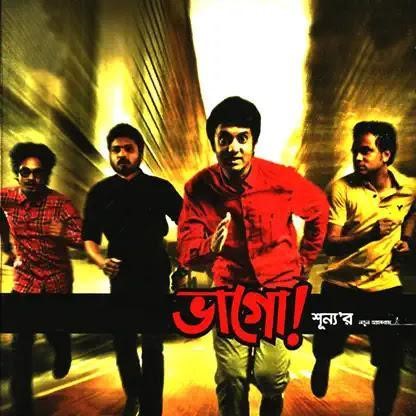
Written by Shahan Kabondho and
produced by Fuad Al Muqtadir— Shono
Mohajon, originally released in 2014, truly cemented their legacy during
the protests. The song’s message of resistance against power structures gained
a new life as students used it across social media and in videos-reels, turning it into a symbol of
resistance.
Shono Mohajon, surprisingly, was never intended to carry a political message. Rather, the song captured a universal feeling of oppression under dictatorship, with its lyrics reflecting a poignant cry against the abuse of power.
The chorus part that impacted people the most goes—
"আমার বিচার তুমি কর, তোমার বিচার করবে কে?
কবে তোমার দখল থেকে, মুক্তি আমায় দেবে?
শোন মহাজন, আমি নয়ত একজন
শোন মহাজন, আমরা অনেকজন"
"You judge me, but who will judge you?
When will you free me from your control?
Listen, lord, I am not alone.
Listen, lord, we are many in count."
The lyrics that once spoke broadly about power and oppression, seemed directly relevant to the anti-discrimination student protest that surged in July, calling for an end to corrupt governance and repressive rule. The song was shared widely across social media, accompanying videos of protests, and its message spread far beyond its original scope.
In addition to the song's relevance, Shunno’s band members showed their solidarity personally. As the protests reached their peak, one member changed his profile picture to solid red, symbolizing support for the students. Meanwhile, the band, while performing in Toronto, dedicated their shows to the protesters, using their platform to bring attention to the ongoing crisis in Bangladesh.
Beyond its musical success, Shono Mohajon’s resurgence during the July Revolution stands as a powerful reminder of music’s ability to inspire and unite. It also emphasizes the vital role artists play in times of political upheaval, raising awareness and offering solidarity through their art.
Bhoy Banglay// Shayan
Farzana Wahid, popularly known as Shayan, is known for using her music as a medium of political resistance. Known for her outspoken stance, Shayan’s song "Bhoy Banglay" has struck a chord with protesters across Bangladesh. Originally written in 2019 to honor Abrar Fahad, the song reflects on the authoritarian grip of the current government. Its resonant lyrics— to fight back and speak out clearly—demand citizens reclaim their nation from power elites who sow division and corruption.
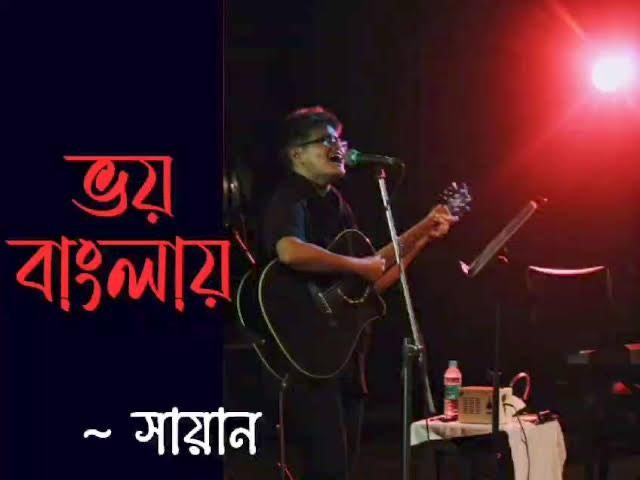
Shayan uses this track to call out
political parties that, despite being loved by many, have blackened the faces
of their own people. The song has become a voice for those disillusioned by the
government’s failure to live up to democratic ideals, urging listeners to take
the country's fate into their hands and clean the “filth” that has engulfed
Bangladesh.
Amar Shurjo
Shayan continues her powerful protest anthems with "Amar Shurjo" (My Sun), as she mentions, “A tribute to the lost lives and the spirit on the rise....”, reminiscing the revolutionaries who face danger for the sake of justice. In the song, Shayan expresses a deep desire to follow in the footsteps of those courageous individuals who embrace sacrifice, finding peace even after walking the fiery path. Lyrics, like "Thankfully you had the courage—Even after being burnt to ashes on the path of fire, I find peace…", reflect her admiration for those willing to give everything for change. The song has resonated deeply with her audience, garnering admiration on social media.
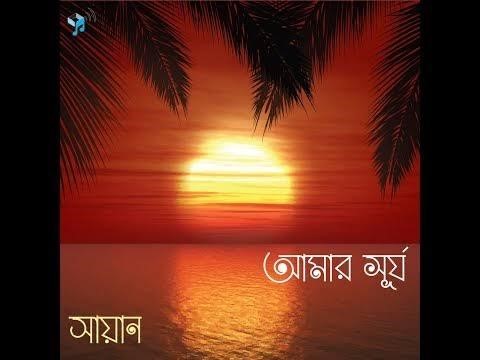
Continuing her tradition of
politically charged releases, "Amar Shurjo" stands as a powerful
statement on resistance and the unwavering spirit of Bangladesh's
revolutionaries. Shayan remains a leading voice in using music to challenge
authoritarianism and inspire collective action.
Ekta Chakri/Chakri Nai Deshe// Gogon Sakib
Gogon Sakib is a Bangladeshi singer and songwriter known for creating songs that resonate with everyday struggles, particularly those faced by the youth.
His music often touches on social issues like unemployment, with a mix of humor and poignant social commentary. "Ekta Chakri" by Gogon Sakib is a humorous yet poignant commentary on the struggles of unemployment in Bangladesh.
The song, written from the perspective of a jobless man, touches on the frustrations of waiting for a job despite holding a degree, and the societal pressures that come with it.

With lyrics such as "If my
uncle was somebody, I'd get the job," Sakib highlights the often corrupt
and nepotistic job market. During the protest, Gogon sakib tributed this song
to Abu Sayed, insinuating the life loss for fighting against the unjust quota
system in government jobs.
Later he released another song named "Chakri Nai Deshe" that similarly addresses the issue of unemployment in Bangladesh. The lyrics express deep societal challenges, touching on themes like nepotism, economic hardship, and the pressure to secure a livelihood.
The song resonates with the general
discontentment in the country regarding job scarcity, making it relevant during
protests that focus on employment and economic reforms.
Cholo Bhule Jai// Parsha Mahzabeen
With a ukulele in hand, Parsha Mahzabeen's poignant song "Cholo Bhule Jai" had gone viral, resonating deeply with audiences during the quota reform movement.
Released on social media, the song quickly garnered over 5 million views within four days, transcending age barriers as listeners connected with its heartfelt message.
Praising the new generation’s creativity and expressing pride in their progress, many notable figures had shown their support for Parsha, amplifying the song's reach.
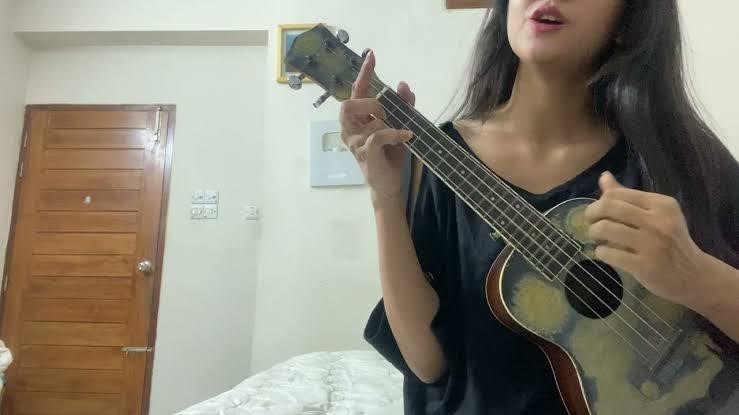
Written in just 10 minutes, the
lyrics of "Cholo Bhule Jai" poignantly address the pain and struggles
witnessed during the protests, with lines urging listeners to forget the scars
of violence and remember the courage of those who stood firm.
With "Cholo Bhule Jai," Parsha Mahzabeen has not only made a mark as a musician but has also captured the spirit of a generation eager for change.
Rokto Gorom Matha Thanda// Kaaktal
Kaaktal is one of the most prominent Bangladeshi bands known for its impactful music, often reflecting social and political themes.
During the quota reform protests in Bangladesh, Kaaktal played a significant role by using their music to express solidarity with the youth and raise awareness about the issues at hand.
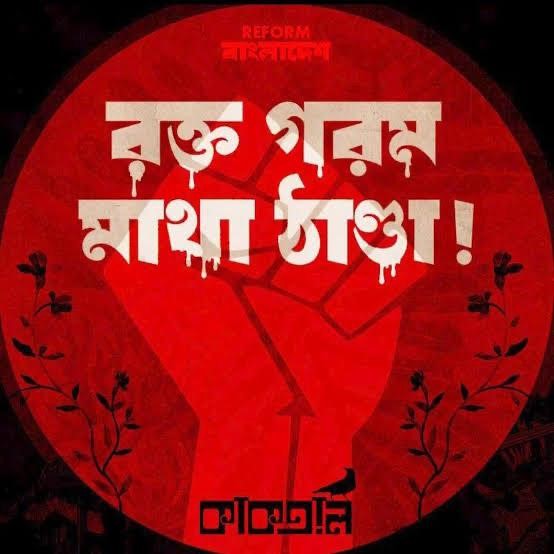
Their songs were praised during the
movement, addressing the frustrations and demands of the protesters. Kaaktal's
music resonates with themes of justice, equality, and resistance against
oppressive system.
One notable song associated with the protests is "Rokto Gorom Matha Noshto,"
“দেশটা কারো বাপের না
সরকার পরিবারের না
দেশের মালিক সব জনগন –তার মধ্যে তুমি।
আমলা- কামলা- উকিল- ডাক্তার আর্টিস্ট থেকে ইঞ্জিনিয়ার-
ছাত্র- পাত্র- বণিক – সৈনিক – সবাই নিয়ম মত দৈনিক
নাথার নাহয় হাতের শ্রমে গড়তাসে এই দেশ তারাইতো বানাইসে সরকার
তাইলে দেশটা বলো কার?
কে কার মালিক- কে কার প্রজা ভাইবা দেখসো কি?
রক্ত গরম মাথা ঠাণ্ডা কইরা দেখসো কি?”
“This country belongs to none,
The government is not our kin.
Every soul who calls it home, you are part of them too.
From the civilised- uncivilised- lawyer- doctor-artist to engineer-
The students, merchants, and soldiers—
This land is forged by their hands,
Not crafted by those in power.
So, I ask you, whose country is this?
Who truly owns it, who shares its fate?
With boiled blood and cool headed,
Have you ever thought of it?”
Kaaktal is celebrated for capturing the collective experiences of people and embedding the realities of human truth into their music.
Their recent release, "Rokto Gorom Matha Thanda," launched on August 2, serves as an open letter to those who hide behind the guise of duty and the allure of greed while perpetrating violence against the future of our nation.
The lyrics offer a sharp critique of the corrupt government, compromised law enforcement, and all those complicit in systemic, widespread violence. Beyond condemning those in power, the track calls for the mobilization of the masses, urging listeners to overcome their fears and stand up for what is right.
Deshta Tomar Baper Naki// Mousumi Chowdhury
In the backdrop of ongoing protests, it was not just the new-age anthems calling on Bangladeshis to 'speak up' that fueled the passion of demonstrators.
Older songs, such as "Desh Ta Tomar Baper Naki" by Ethun Babu and Moushumi Chowdhury, have also made a powerful comeback. Originally released months ago, this 2023 track has become a rallying cry for protesters, serving as the soundtrack that energizes the movement.
With its blunt message of defiance—translated as "Does the country belong to your father?"—the song resonated deeply with those on the streets. The lyrics prompted protestors to reflect on the question of ownership and authority, as they hummed along, fully aware of whom they were addressing.
Ethun and Moushumi's folk-inspired melodies, combined with animated public performances, provoke thoughts about civic responsibility and action.
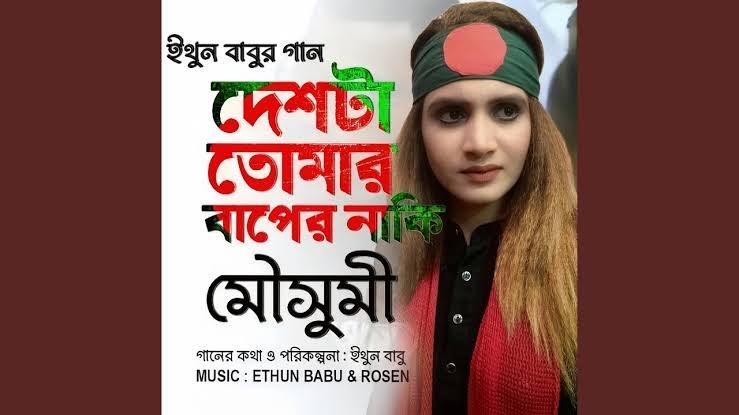
Many listeners found their
sentiments echoed in the lyrics, which remind them that the nation of Bangladesh
was born out of bloodshed. The duo expresses an unwavering commitment to
protect it, declaring, "We won this country through war, by shedding
blood. We are ready to shed blood again."
Lines from the song challenge the status quo, asking,
"Is the country your father's?
Are you pretending, when you get a chance,
you grab the people's throats?
Remember, I got the country by fighting with blood;
I am willing to give blood to save the country. I will not do it by intimidation."
This powerful rhetoric has made "Desh Ta Tomar Baper Naki" an anthem of the anti-Hasina movement and a significant part of the anti-quota student protests.
Ethun Babu, a resident of Moghbazar—an area renowned for its Baul singers—crafted this impactful piece. Meanwhile, Moushumi Chowdhury's voice has gained immense popularity, further amplifying the song's reach.
Recently, the song also made headlines when musician Altap Hussain was arrested in Assam for singing an Ahmia version of "Desh Ta Tomar Baper Naki," which blends the original melody with the rhythm of Assamese Bihu.
He faced allegations that his rendition hurt communal harmony, showcasing the potent mix of music and political sentiment that continues to shape Bangladesh’s social landscape.
The Rise of Bangla Rap
Bangla rap had played a very important role in the anti-discrimination protest in Bangladesh, making it an essential medium of resistance and expression.
Over the last decade, Bangla rap emerged from the underground music scene to become a voice for the youth, capturing their frustrations and anger against systemic injustices.
Bangla rap, innately, was assumed to be the amusement of either low income family kids and young adults growing in poverty or spoiled rich kids, Bangla rap was often considered crude and uncivilized compared to mainstream music.
Since this movement was shaped by a generation that grew up witnessing political corruption, rising inequality, and state-sanctioned violence, the youth brought and revived rap an edge as a potent political tool.
Artists like Shezan Beatz and Hannan Hossain Shimul connected the present movement to Bangladesh's rich history of protest and revolution, evoking memories of past struggles.
Bangla rap not only highlighted state oppression but also urged listeners to raise their voices for justice. The lyrics echoing a call for action critiqued the authorities and invoked the sacrifices of those who died and got injured during the protests.
The power of Bangla rap during the 2024 protests illustrates how music can transcend entertainment to become a force for political mobilization, giving a voice to the marginalized and catalyzing social change.
During the protest, when Hasina regime’s utmost power and the police brutality could not stop people from protesting, a quote by Pablo Neruda became incredibly famous,, "You can cut all the flowers, but you cannot keep spring from coming.’
Dozens of rap songs surfaced despite
all the obstacles on freedom of expression, voicing the demands and
frustrations of thousands of protesters. In the tradition of protest art
worldwide, these fiery artists embodied the resistance, showing that no amount
of oppression could silence the voice of a determined people.
Awaaz Utha// Hannan, SnareByt
Rapper Hannan Hossain Shimul gained national prominence during the 2024 anti-discrimination protests in Bangladesh for his politically charged song ‘Awaaz Utha’ (Raise Your Voice), that encapsulated the anger, grief, and determination of a nation on the brink of revolution.
Released during a time of intense political upheaval, Shimul's song connected with the protesters' frustrations against systemic oppression.
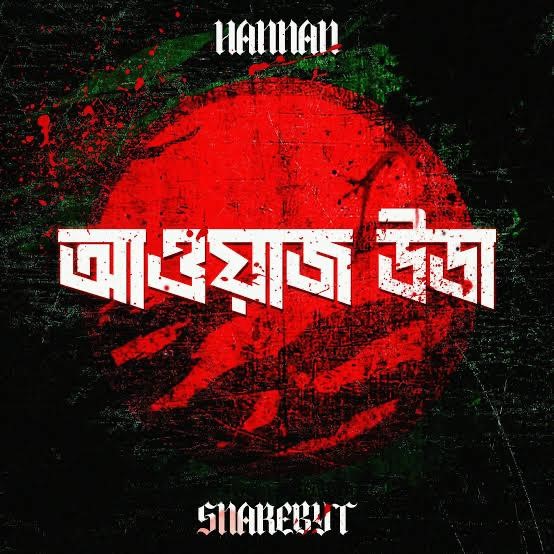
The track begins with a sample from
the poignant nod to Bangladesh’s history, March 7, 1971 speech by Sheikh
Mujibur Rahman,
“এবং তোমাদের যা কিছু আছে তাই নিয়ে প্রস্তুত থাকো
মনে রাখবা, রক্ত যখন দিয়েছি, রক্ত আরো দেবো
এদেশের মানুষকে মুক্ত করে ছাড়বো ইন শা আল্লাহ”
“You must prepare yourselves now with what little you have for the struggle ahead. Since we have given blood, we will give more of it. But, Insha’Allah, we will free the people of this land!”
Hannan then proceeds to urge Bangladesh to Speak up, to question and to raise the voice against all the injustice taking place, all the controvertisalities– raising questions on India’s one sided water negotiations and the deaths on the protest.
“নামসি বুকে পতাকা, দেশ বেচতাসোস কয় টেকা?
সিলেট যহন ডুইব্বা গেসে পানি আইসে কই থেকা?
আবু সাঈদরে গুল্লি করলি order দিলো কই থেকা?
এবার রাস্তায় লাখো সাঈদ কইলজা থাকলে ঠেকাগা!”
“Hearts bear a flag—what’s the cost of this state?
When Sylhet drowned, from where did the waters came?
You murdered Abu Sayed; who commanded you to do it?
Now, millions rise as Sayeds on streets— come try to resist!”
Hanna's lyrics were direct and confrontational, questioning the powers that be: Whose blood stains the streets? and Who killed my brothers and sisters? Such lines landed Shimul in jail on July 25, 2024, in Narayanganj, where authorities detained him under vague legal pretexts.
His arrest only fueled the growing momentum of his song, which continued to spread rapidly online, gathering over 23 lakh views.
Hannan’s song took direct aim at the country's leadership, accusing them of betraying the ideals of Bangladesh.
One of the lines, The tyrant sits in power on people enduring many things, was interpreted as a reference to Sheikh Hasina's government, with other lyrics suggesting her regime was selling out the nation’s interests. Other than Abu Sayeed, the song also paid tribute to the fallen activists, Asif, Rafi, and Wasim Adnan, who became martyrs during the protests.
Despite his imprisonment, Awaaz Utha continued to resonate with the protesters, many of whom saw it as a battle cry and a call to action against the status quo. Hannan was released from jail only after Hasina resigned and fled the country on August 5, further solidifying his position as a key figure in the protest movement.
Kotha Ko// SHEZAN
Rapper Shezan, popularly known as Shezan Beatz, unleashed a wave of defiance on July 16, 2024, with his track "Kotha Ko," which quickly amassed over 1.6 million views on YouTube.
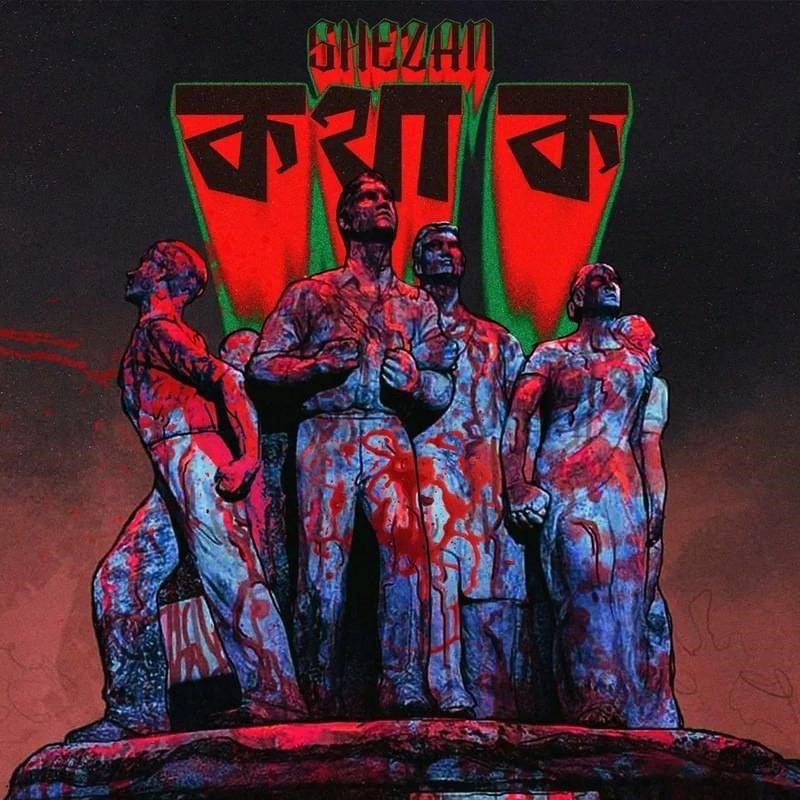
The song’s hard-hitting lyrics made
it immediately popular among the protestors all across Bangladesh, directly
confronting the situation of the nation. The song questions the difference
between 1952 and 2024, demanding answers from those in power for the continued
oppression faced by the people:
"Where’s the difference between 52 and 24? Speak up!
If the country claims freedom, where’s the freedom? Speak up!
My siblings die on the streets, are you even trying? Speak up!"
The track struck a chord with students who saw Shezan’s lyrics as a call to action. It reminded them of the 1952 Language Movement, when Dhaka University students defied West Pakistan’s imposition of Urdu on Bengalis, leading to deadly police crackdowns.
The song draws a stark parallel between the struggles of 1952 and the protests in 2024, invoking memories of the fight for Bangla as an official language.
As Bangladesh grapples with widespread protests, Shezan’s song stands as a bold critique of the government’s actions, particularly without directly naming Prime Minister Sheikh Hasina. "Kotha Ko" condemns the hypocrisy of the ruling powers, accusing them of using the same oppressive tactics once employed by their predecessors.
Shezan highlights the betrayal of the nation’s founding ideals, lamenting how the red-green flag, once a beacon of hope, had turned "fully red"—a metaphor for the bloodshed under the current regime.
The song also references the term "Razakar," a label used by Sheikh Hasina’s government to discredit protesters, comparing them to the traitors who collaborated with Pakistan in 1971. Shezan’s critique cuts deeper, addressing the use of force against peaceful demonstrators and questioning the legitimacy of a leadership that "broke the pen with the baton, raised arms in the name of peace," alluding to how the government silenced dissent.
With "Kotha Ko," Shezan has become the voice of a generation standing against repression, demanding justice, and questioning the true meaning of independence in modern Bangladesh
Slogan// Mcc-e-Mac ft. GK Kibria
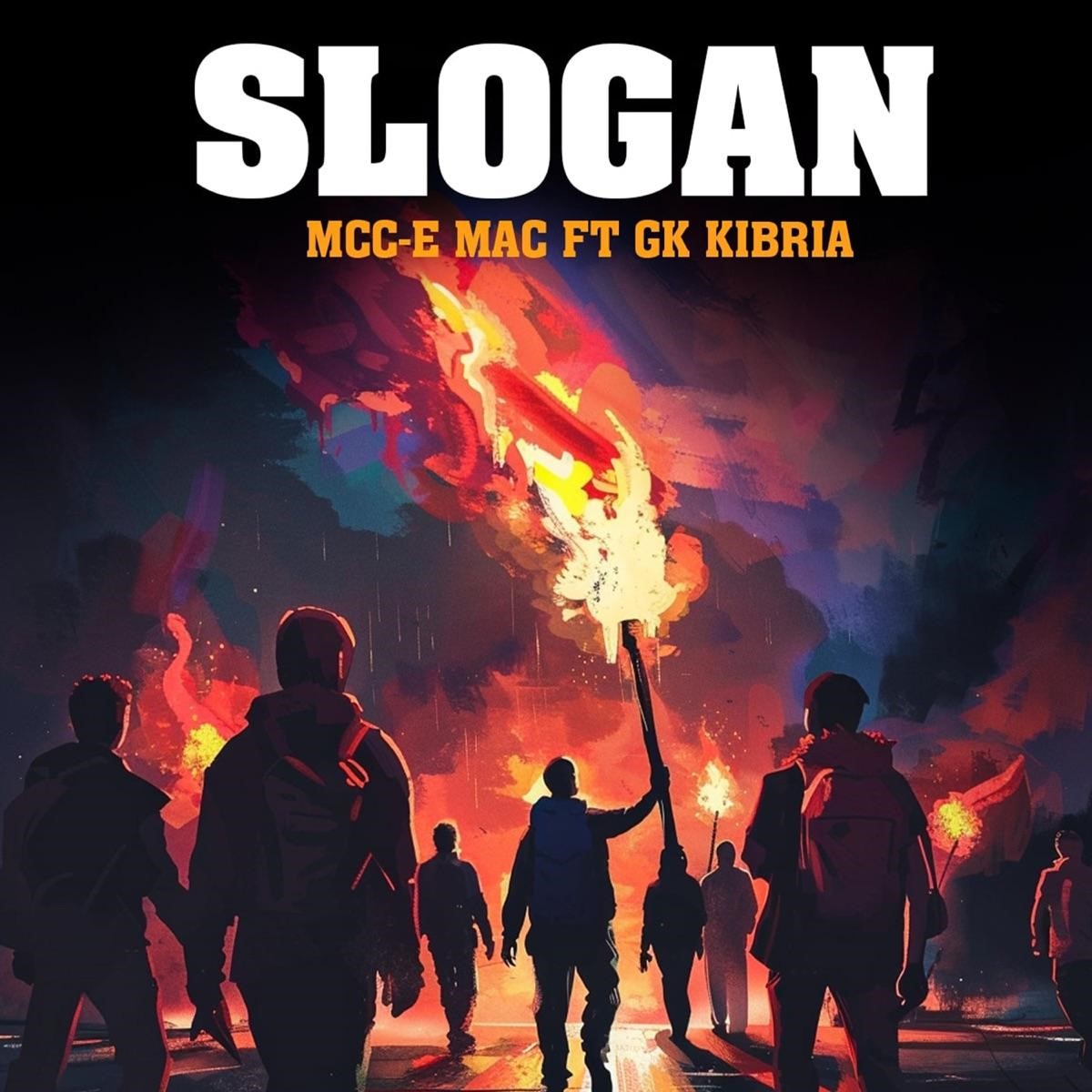
The song "Slogan," a
powerful collaboration between Bangladeshi artists Mcc-e-Mac and GK Kibria,
emerged as one of the defining tracks of the 2024 Quota Reform Movement.
Released in the midst of nationwide protests, the track demanded an end to
government corruption. Its sharp lyrics, set against a backdrop of contemporary
hip-hop beats, resonated with the youth on the streets, making it a rallying
cry for those fighting against oppressive systems–
“হে লড়াই চলবে লড়াই
গুলি মার বুকে তবু আমি না ডরাই
কর ক্ষমতার বড়াই
কুলাঙ্গার রাস্তায় নেমে গেলে
হোক লড়াই
হেই লড়াই
কোটি ছাত্রের লড়াই
আন্দোলন আজ চলছে চলবেই
রাজপথে আয় তোরা দলে দলে
আজ অধিকারের লড়াই ”
"Keep shooting yet I am not afraid of the bullet
Keep Bragging about power
If all those disgraces join the street
Then let's fight
This fight
Fights of Millions of students
The movement lives, it carries on today
Come to the streets in groups
For today we fight,
For our rights, come what may."
“এইটা বাংলাদেশ,রক্ত ঝরুক ঝরতে দে
এইটা বাংলাদেশ, আমার ভাইয়ের রক্ততে
এইটা বাংলাদেশ, ৫২ থেকে ২৪ এই
এইটা বাংলাদেশ, ভয়ে ভুলে জয় করবে যে”
"This is Bangladesh, let the blood flow
This is Bangladesh, in my brother's blood
This is Bangladesh, from 52 to 24
This is Bangladesh, will win casting the fear aside."
Mcc-e-Mac and GK Kibria are artists who have become known for their protest music, addressing social issues and authoritarian power with a distinctive blend of rap and lyrical activism. Their other song titled Inquilab became popular as well during the protest.
With "Slogan," the duo taps into the tradition of using music as a tool to unify protestors, fuel movements, and amplify the demands of the disenfranchised. Their collaboration in the protest landscape highlights how artists continue to play a critical role in driving social and political change in Bangladesh.
Desh Shongskar// Gold Cube
Gold Cube is a Bangladeshi band known for its engaging music that often blends various genres, including rock, folk, and pop.
Formed in the early 2010s, the band is recognized for addressing social and political themes in its lyrics, making their songs resonate with a younger audience concerned about national identity, social justice, and civic responsibility.
Their original "Desh Shongskar" highlights their commitment to patriotic themes and the importance of unity among the people of Bangladesh.
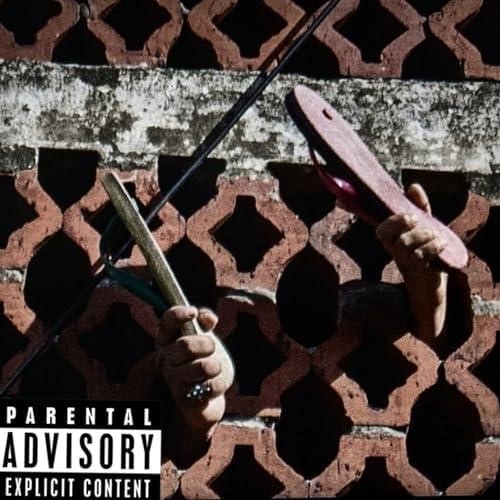
The song begins by quoting Sheikh Mujibur Rahman, "Whatever I bring
here begging, these bootlickers strip it
away! My poor people are left with nothing. These thieves! I don’t know where
they came from.
The Pakistani tyrants may have left, but they left us with these! I wish they had taken these thieves with them."
Then the band proceeds to the main song, resonating with the quote, how the system is corrupted, with very cleverly mentioning the driver Abed Ali’s BCS question leaking controversy, the artist slowly proceeds how every system is now based on corruption, robbery and betrayal to mass. The song threats the ruling regime for trying to silence them down-
“আমাদের এই স্লোগান পারবে না তুমি থামাতে
লাশের পাহাড়ে লুকিয়ে কতদিন আর বাঁচবে?”
“You cannot stop our slogans coming
How long will you really live hiding the mountains of corpses?”
“ছাত্র যদি ভয় পাইতো বন্দুকের গুলি
উর্দু থাকতো রাষ্ট্রভাষা
উর্দু থাকতো বুলি”
“If the students were really afraid of gunshots,
Urdu would have been the state language
Urdu would have been the language I speak.”
Gold Cube has a growing fan base and continues to contribute to the music scene with their thought-provoking lyrics and dynamic performances, aiming to inspire positive change and encourage dialogue among listeners.
Desh Kar?// Lunatix Veer and Rhythmsta
Desh Kar? by Lunatix Veer and Rhythmsta is a one of the most listened rap songs that gained prominence during the 2024 uprisings in Bangladesh, particularly amid the Quota Reform Movement.
This track, released on 18th July, filled with themes of rebellion and national discontent, questions the true ownership of the country and criticizes the state's handling of governance, corruption, and the loss of life during protests.
The artist is part of a new generation of Bangladeshi rappers who have used their music to channel the anger and frustration of the youth. Desh Kar? asks who the country really belongs to—its people or those in power—while demanding justice and equality, similar to the chants of the protesters on the streets.
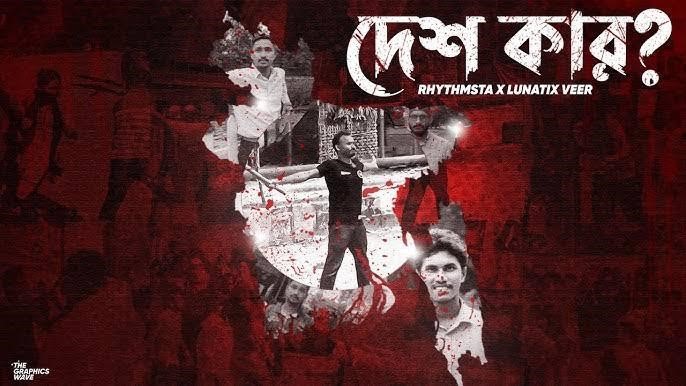
The song reflects the long-standing
tradition of resistance music in Bangladesh, much like the songs from the
Liberation War era, while embracing contemporary Bangla.
The track honors those who sacrificed their lives for justice, notably Abu Sayeed, who was killed during the protests. Desh Kar? resonates with protestors' calls for merit-based opportunities and accountability, echoing the broader demands for transparency in governance and an end to oppressive systems.
The song shares its message with others like "Quota na Medha?"—also dedicated to Sayeed—which questions whether the country will be ruled by merit or continue to be marred by unjust quota systems.
Chobbisher Guerrilla// 24 Er Guerrilla
The rap song "Chobbisher Guerrilla" by 24 Er Guerrilla has emerged as a powerful anthem for the youth-led movement in Bangladesh.
This movement arose in response to controversial comments made by Sheikh Hasina regarding students involved in the quota reform initiative. In solidarity with the students, 24 Er Guerrilla released their rap song to amplify the call for justice.
In this protest, the cultural aspect played a significant role, with rappers inspiring the youth through their straightforward lyrics.
During the Liberation War, guerilla fighters strategically battled against the Pakistani army. Now, in this warlike protest against fascist rule and police brutality, artists have taken on the responsibility of fighting back by raising their voices through their art.
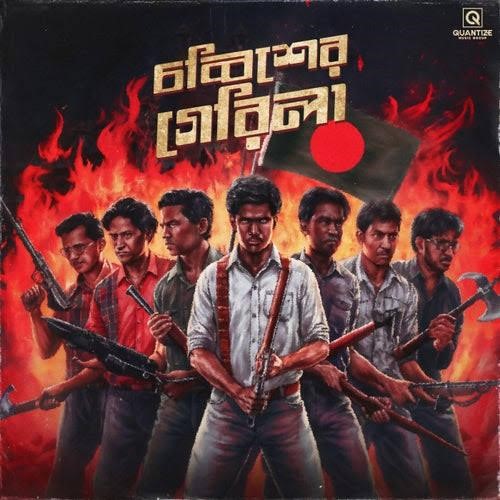
Produced by Sami Tonmoy, the song is
divided into eight parts, each assumed to be performed by a different member:
Critical Mahmood, Shooter 47, Rimon Dimon, Soldier Br, Safayet Jisan, Sami
Tonmoy, GxP, and SoMrat Sij. The chorus incorporates the most famous slogan
that resonated with protesters after Hasina labeled them as "rajakar
“আমি কে? তুমি কে? রাজাকার, রাজাকার
কে বলেছে? কে বলেছে? স্বৈরাচার, স্বৈরাচার!”
Daam De// Crown Engine
"Daam De" by Crown Engine is a rap song that gained attention during the anti-authoritarian regime movement. The song embodies the price of fighting for freedom. Syed Abir Ahmed, better known by his stage name Crown Engine and by his easy poetry style Eazy poet, is a Bangladeshi rapper, recording artist, performer, songwriter.
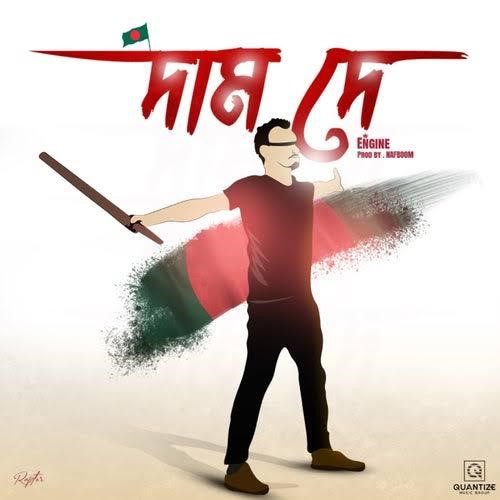
The song is believed to have been
part of the broader cultural wave of protest music that supported the demand
for the resignation of Prime Minister Sheikh Hasina and the fight against
discrimination and authoritarianism in Bangladesh. Along with other protest
anthems, “Daam De” resonated with the youth, fueling their revolutionary spirit
through music–
“বাতাসে লাশের গন্ধ কার হাতে বন্দুক কে গুলি চালায়
বদলায় গেসে তাপমাত্রা, হাতে রামদা নিরীহর খুলি ফালায়
৫২ হুনসি ২৪ দেখসি, শহীদরা কেমনে জন্মায়
বারূদ ভরা গ্রেনেড সামনে আয়া পড়ে শরীল ঝলসায়”
“Air thick with the scent of death
Who fired the gun?
As temperaments shift,
Ramda cracked open innocent skulls.
I heard of 52, but saw only 24.
That how martyrs are born
And how do grenades, packed with gunpowder, explode their bodies?”
One reason why people connected with and felt inspired by Bangla rap during the protests was the genre's directness and refusal to obscure national issues and the suffering of the people.
Unlike many mainstream songs that rely heavily on metaphors and aestheticism—often losing relatability by maintaining overly polished language—Bangla rap embraced rawness.
Its lyrics were aggressive and unflinchingly addressed the Hasina regime, demanding accountability for corruption, police brutality, and the loss of lives.
It was as if mourning would only come after those in power answered for their actions. The rap songs also boldly tackled controversial subjects, such as the silence of public figures and influencers, as well as the Awami League's influence on historical narratives, education system etc.
-----
Ayesha Humayra Waresa is a freelance writer. Reach her at [email protected]

